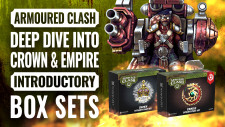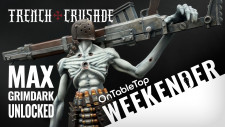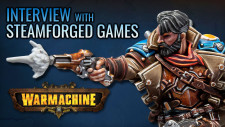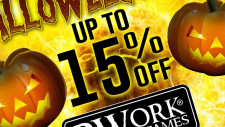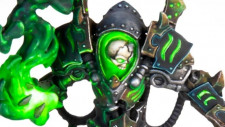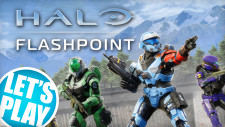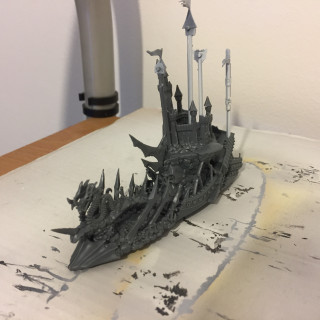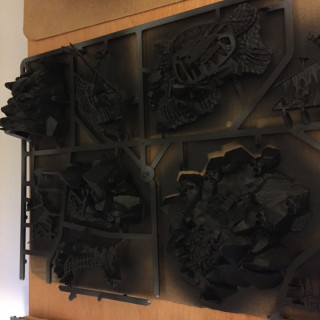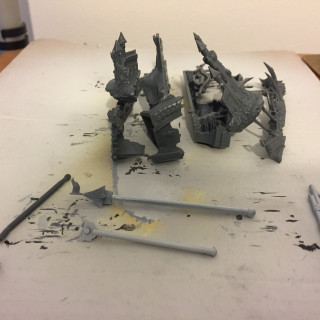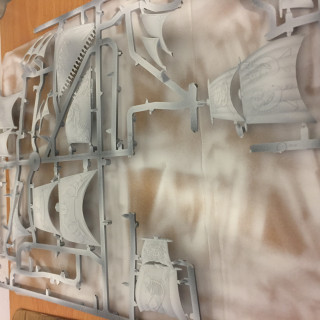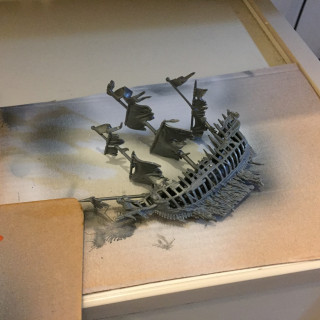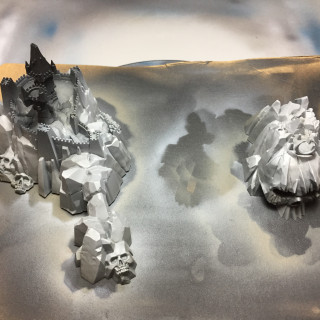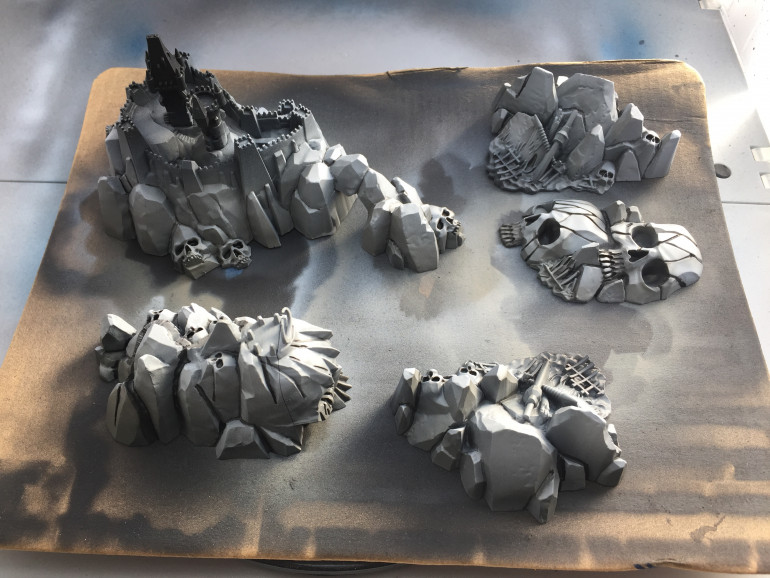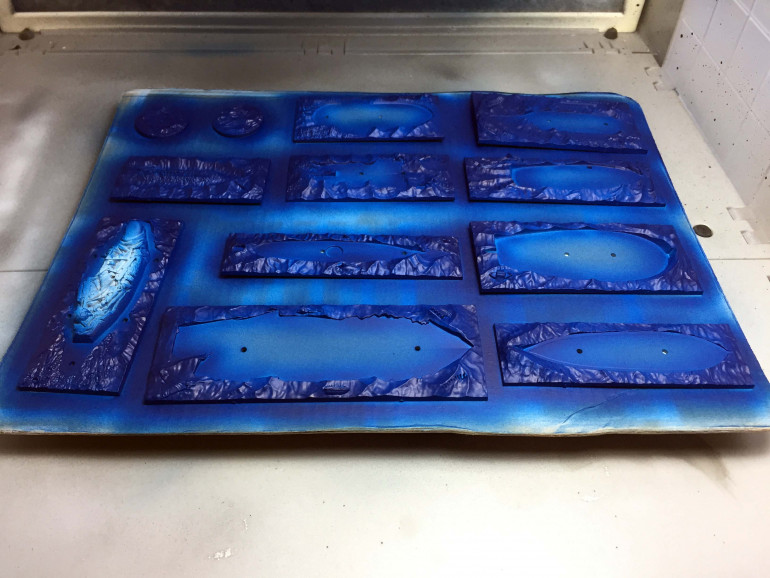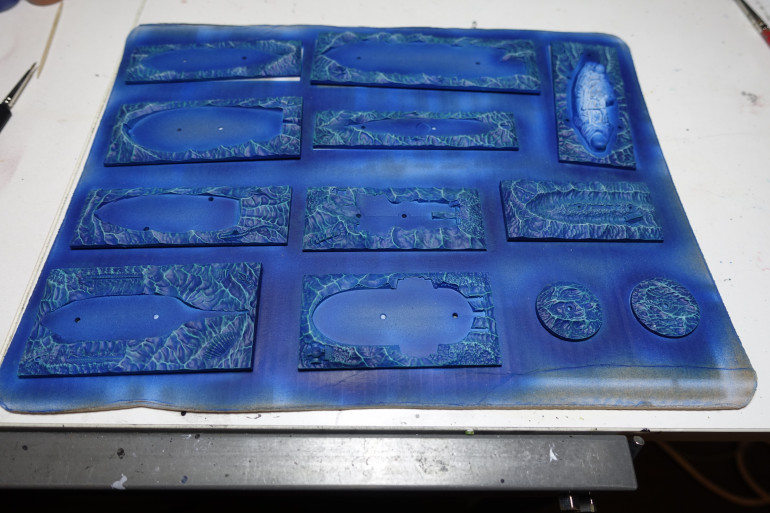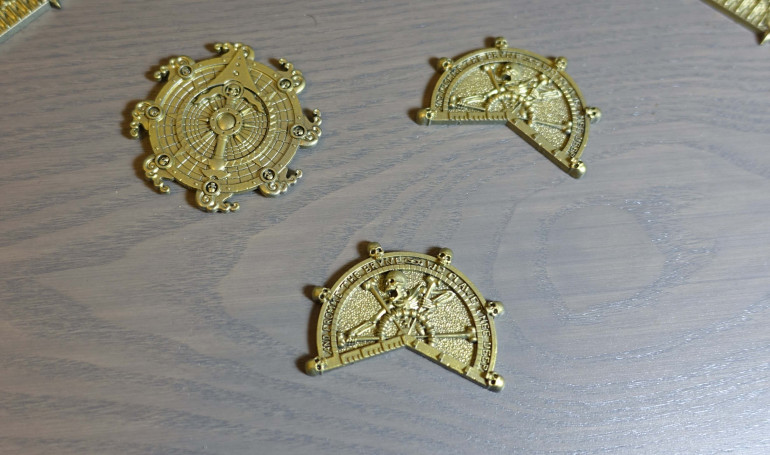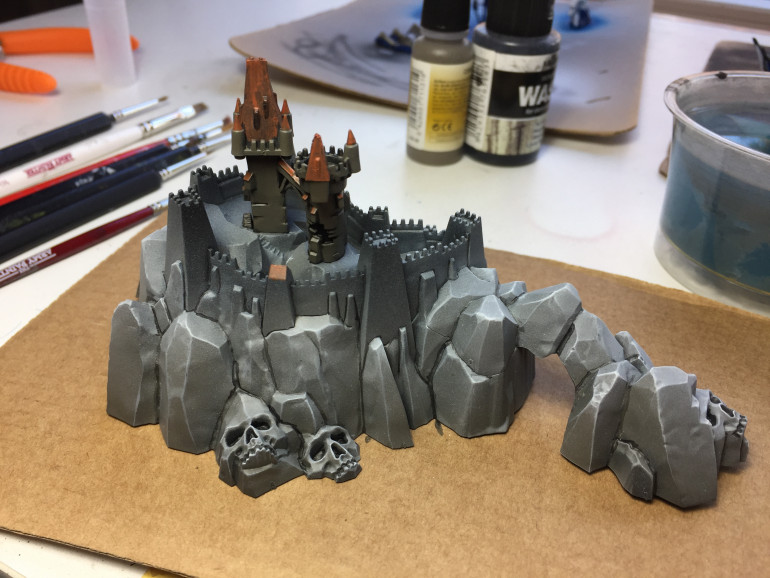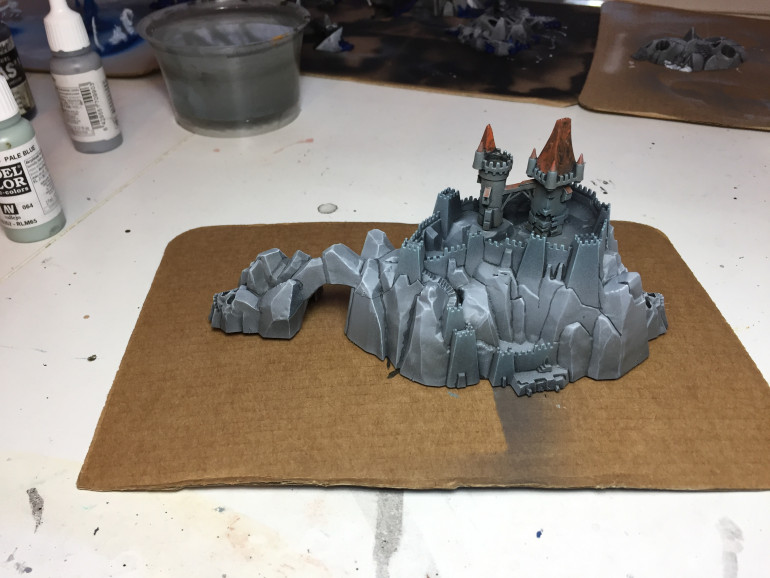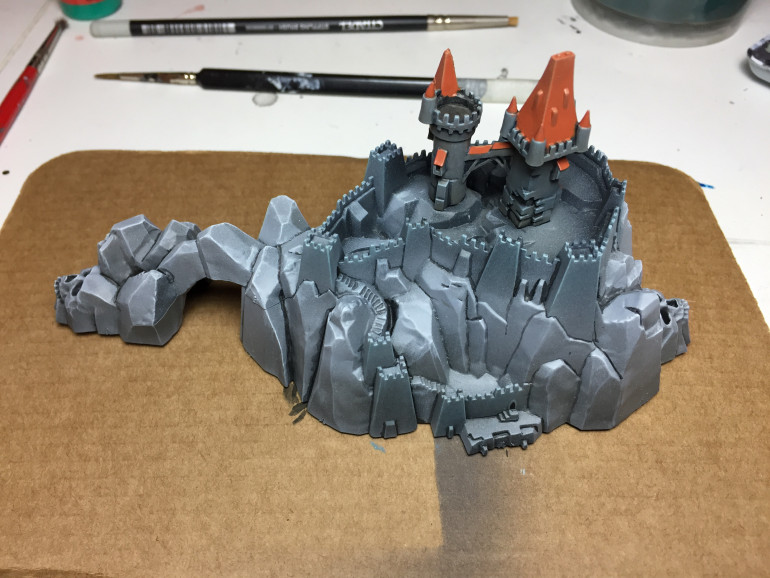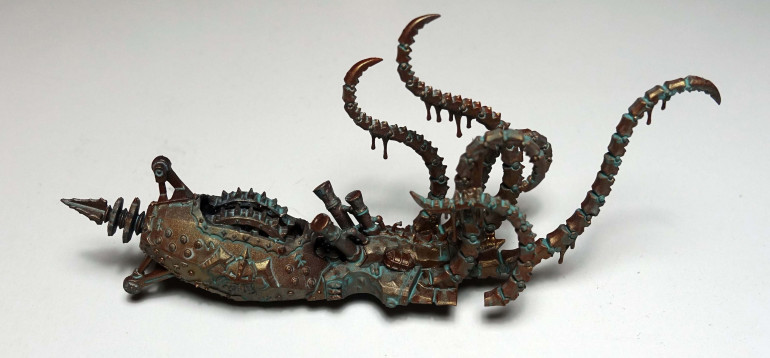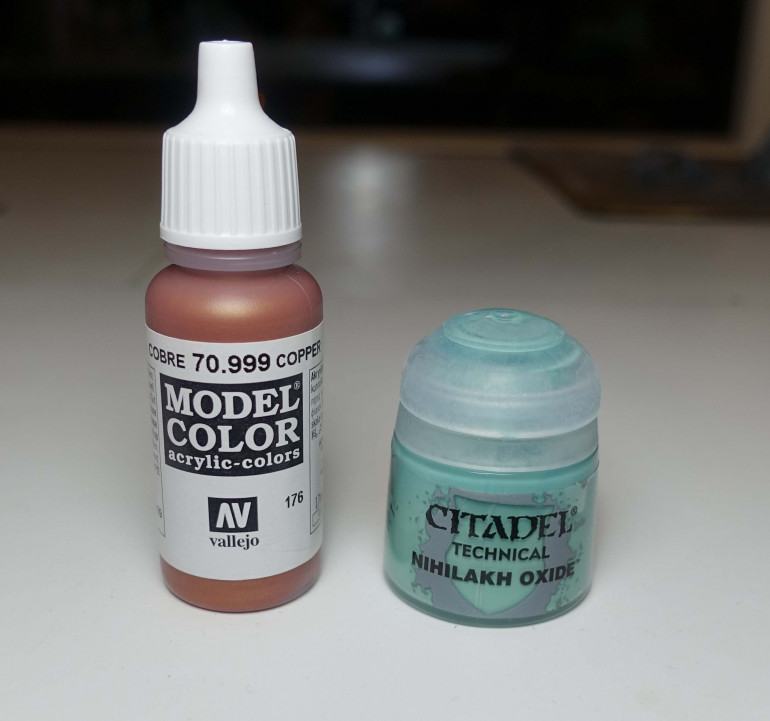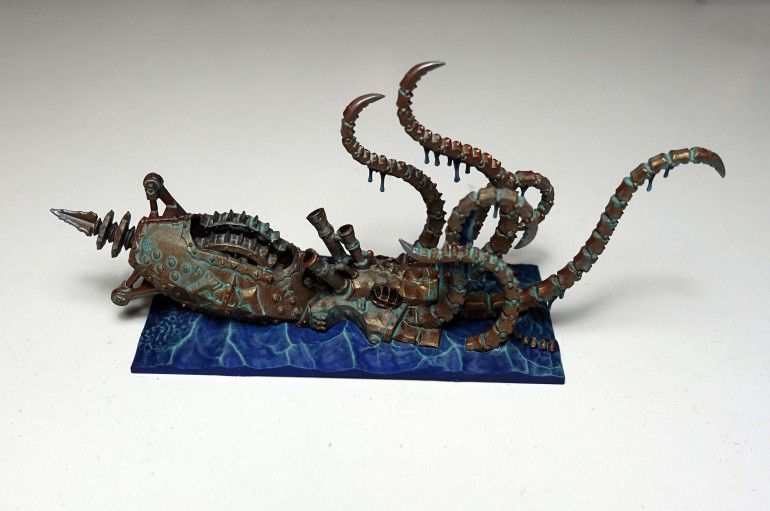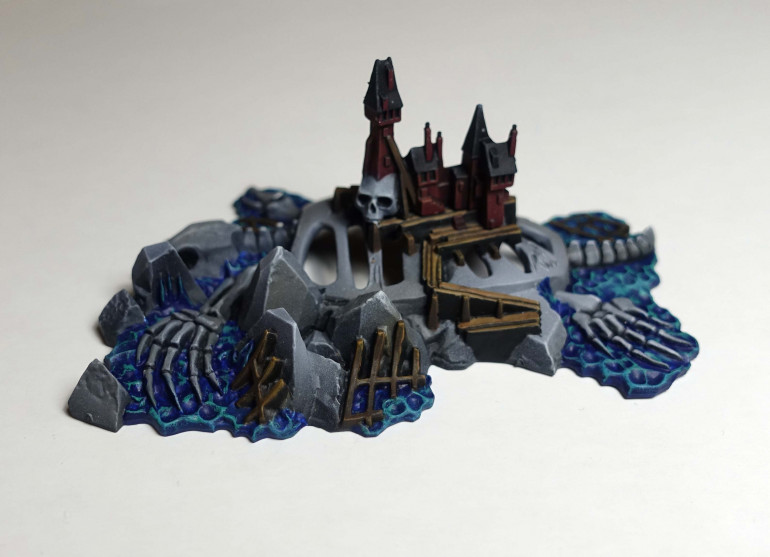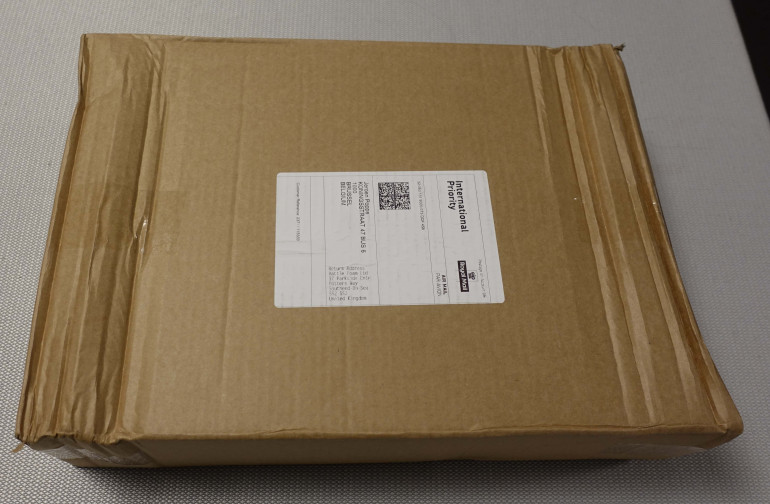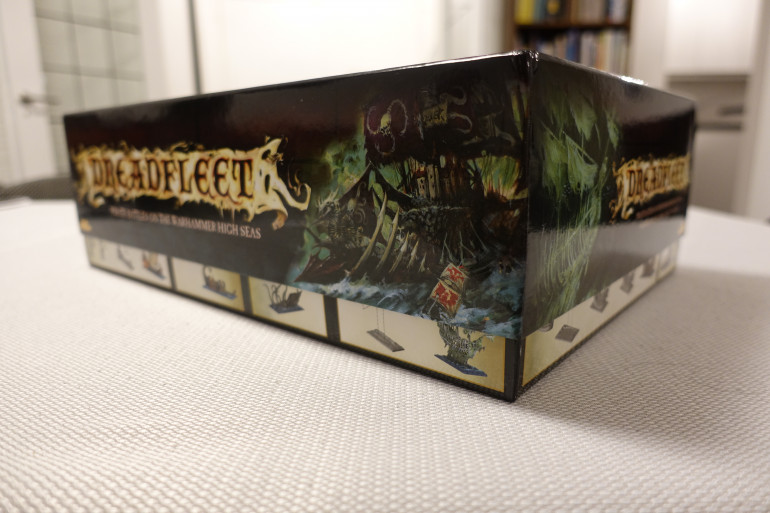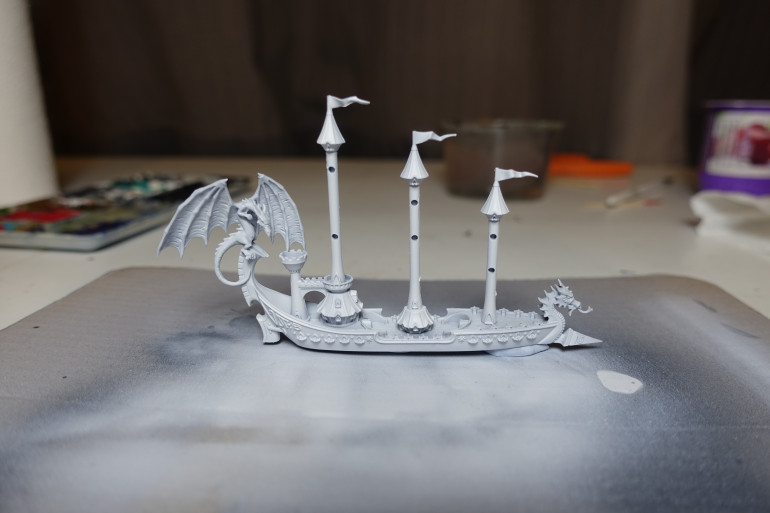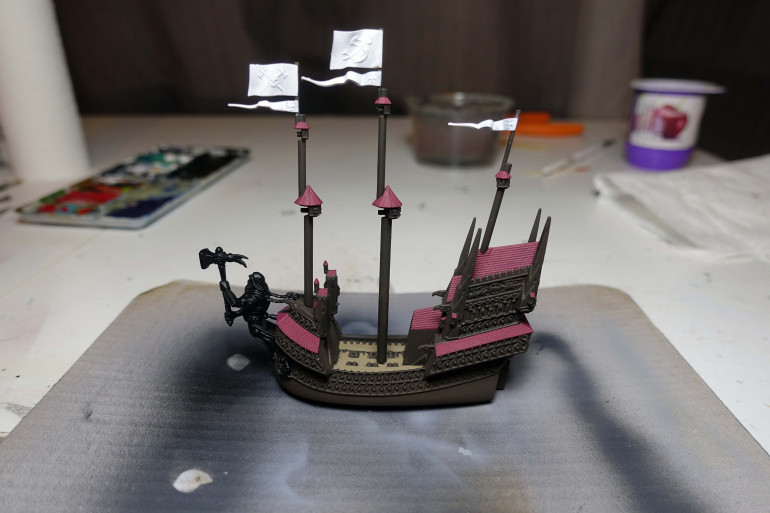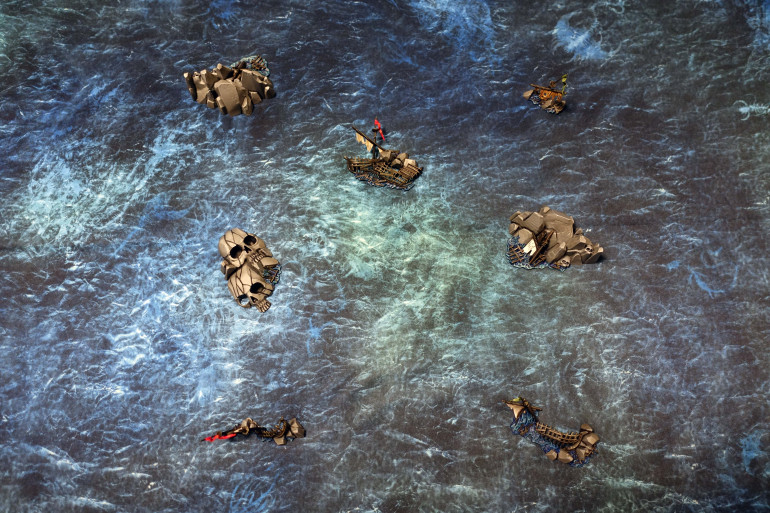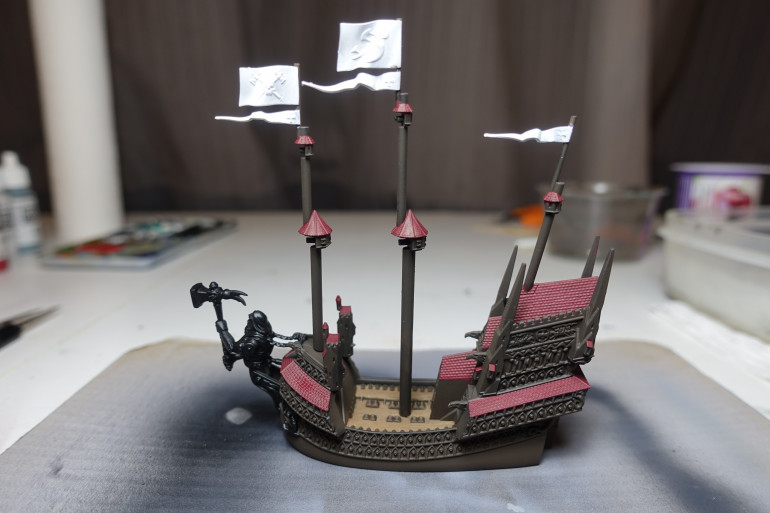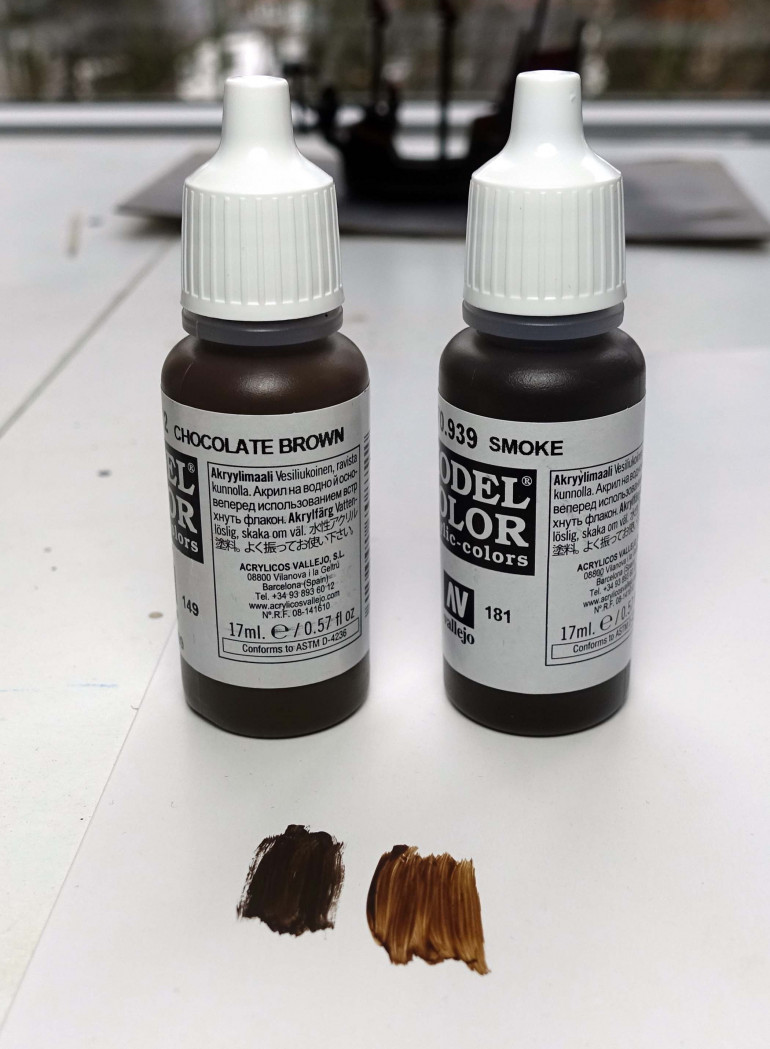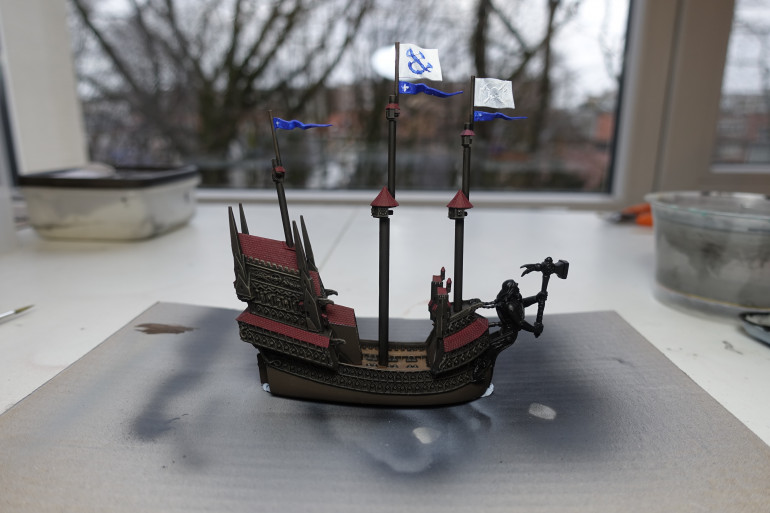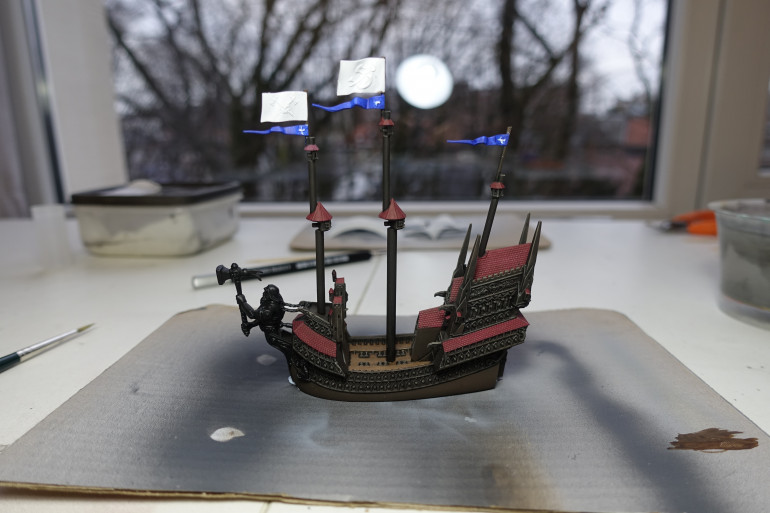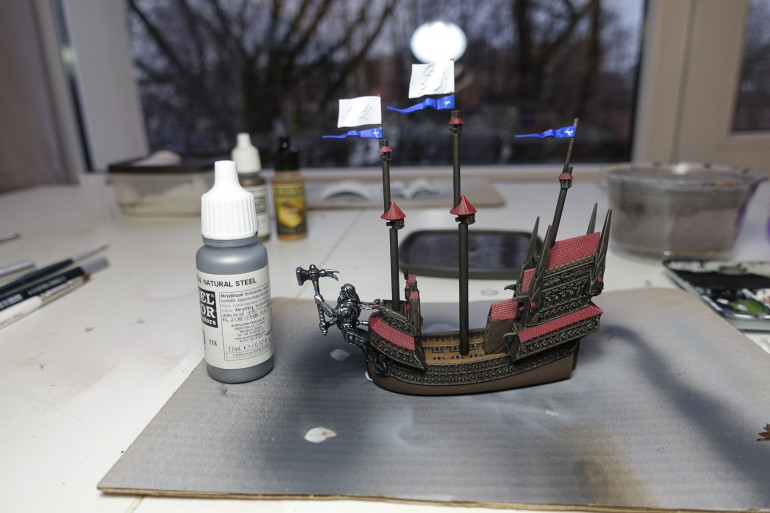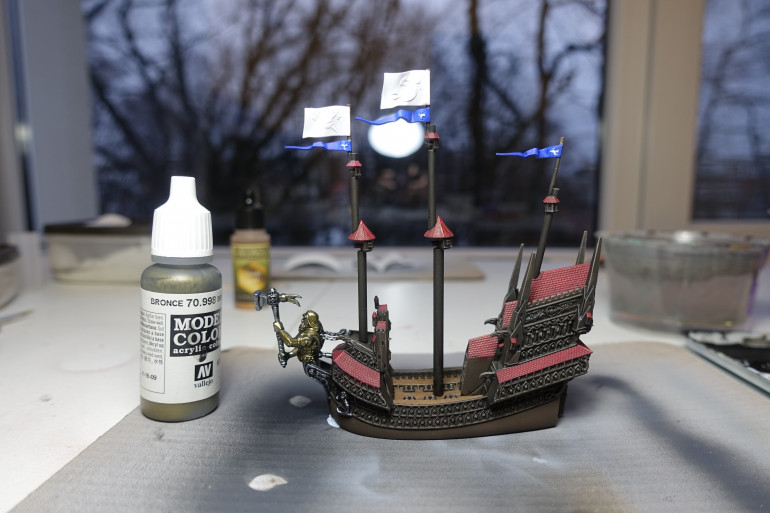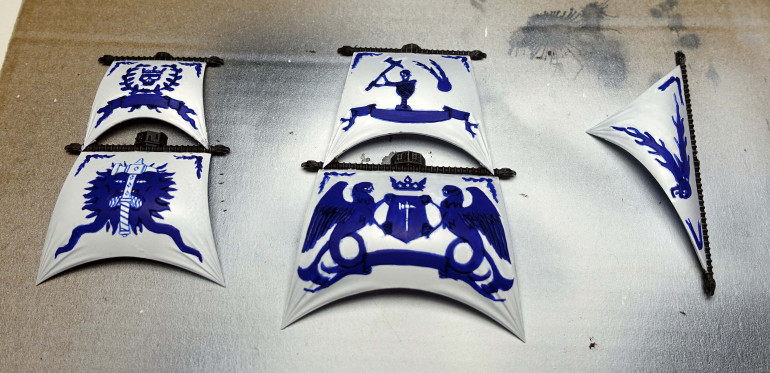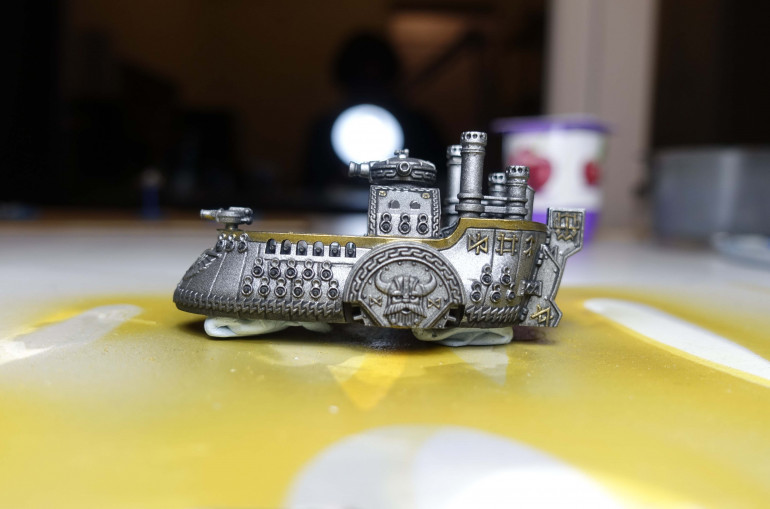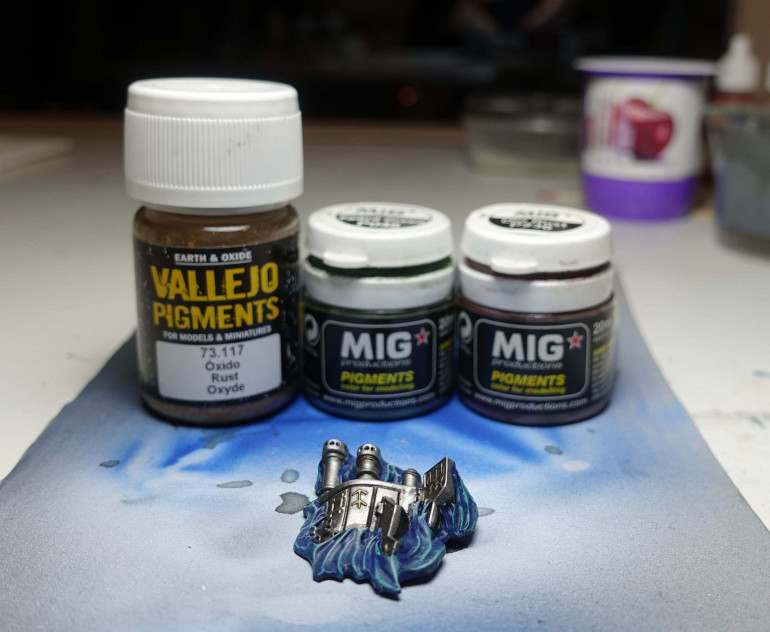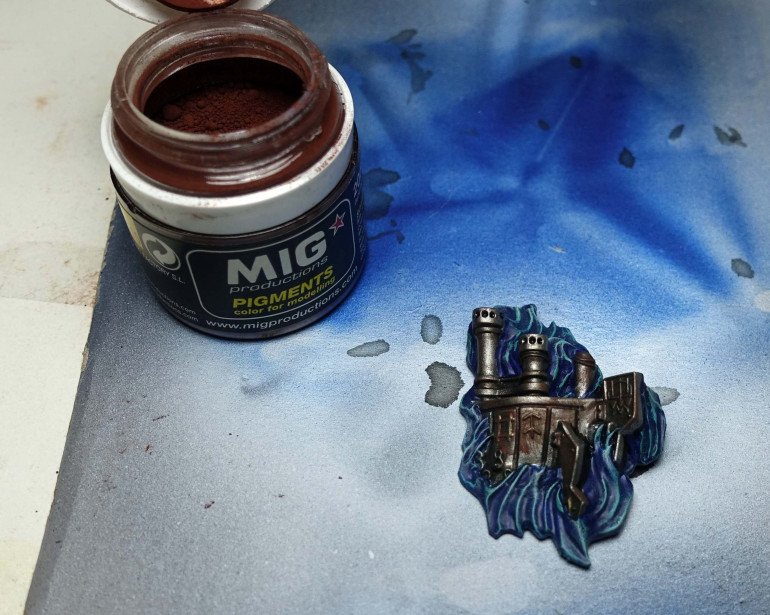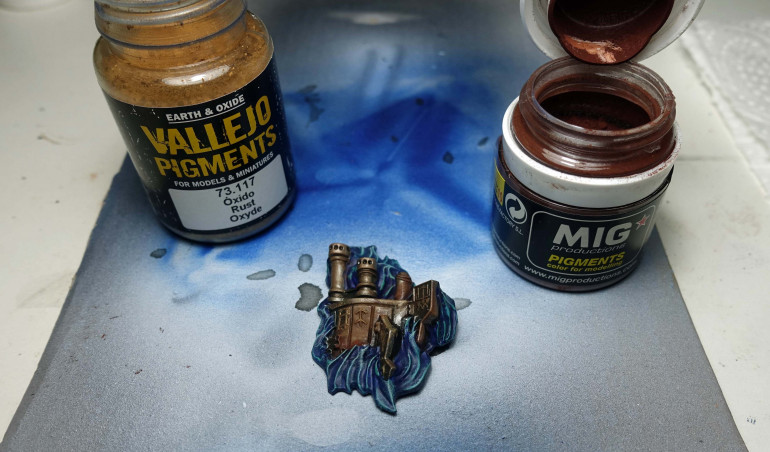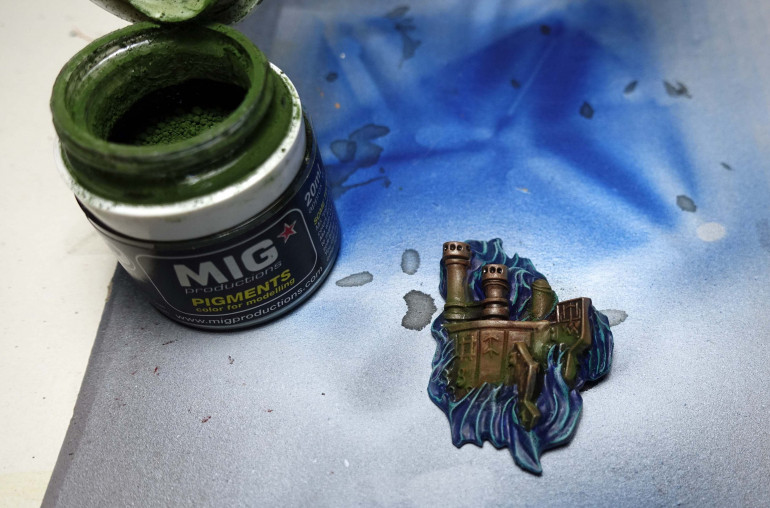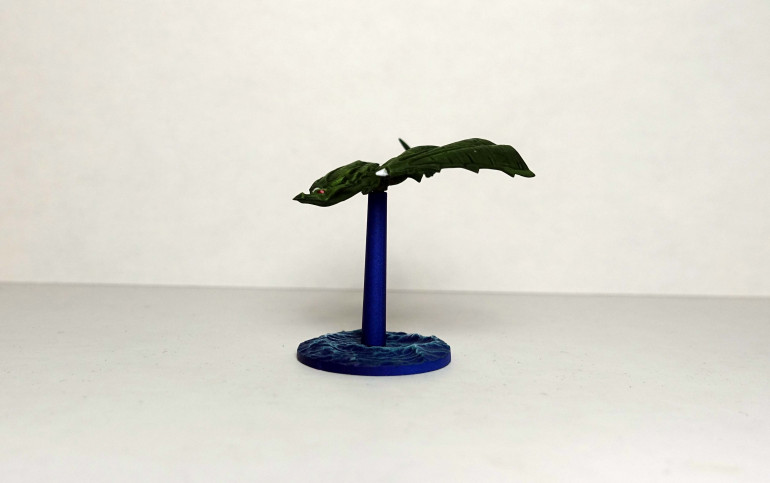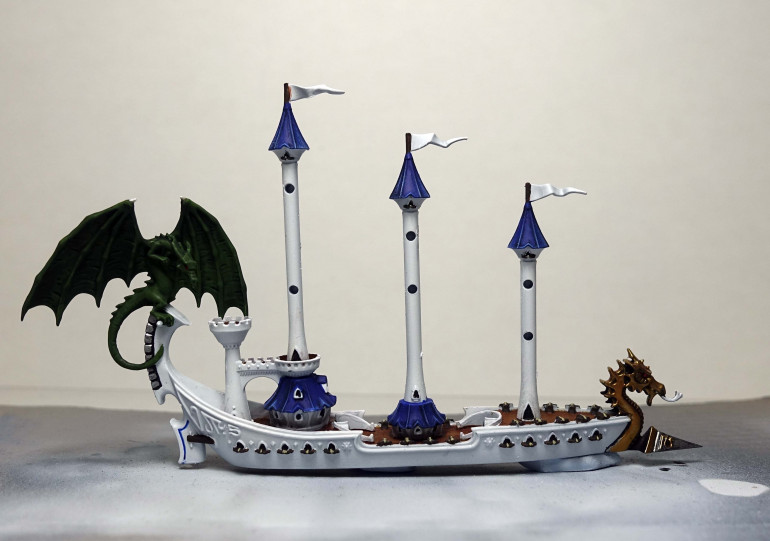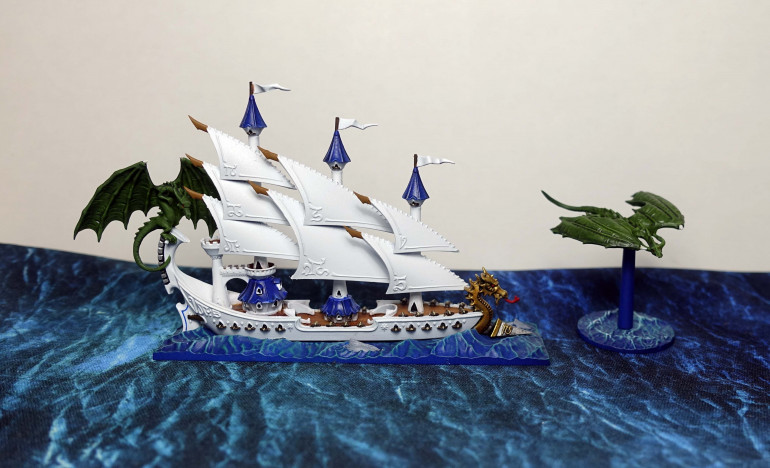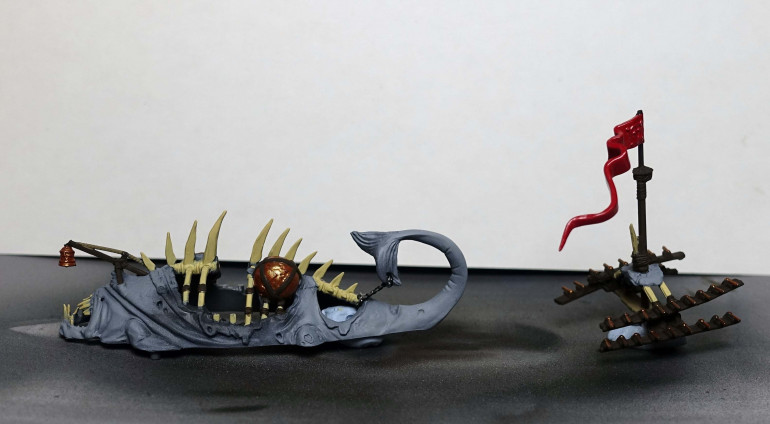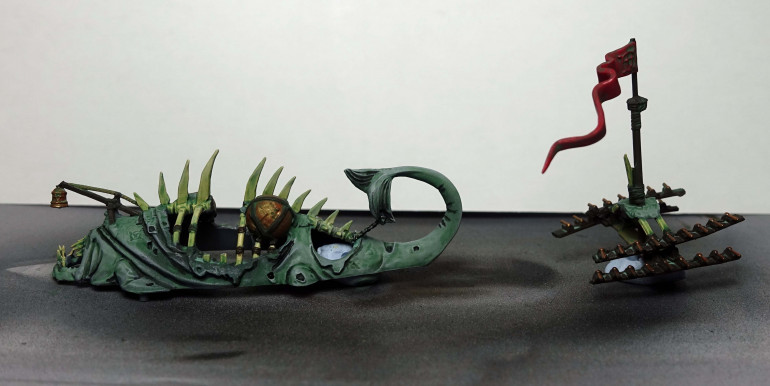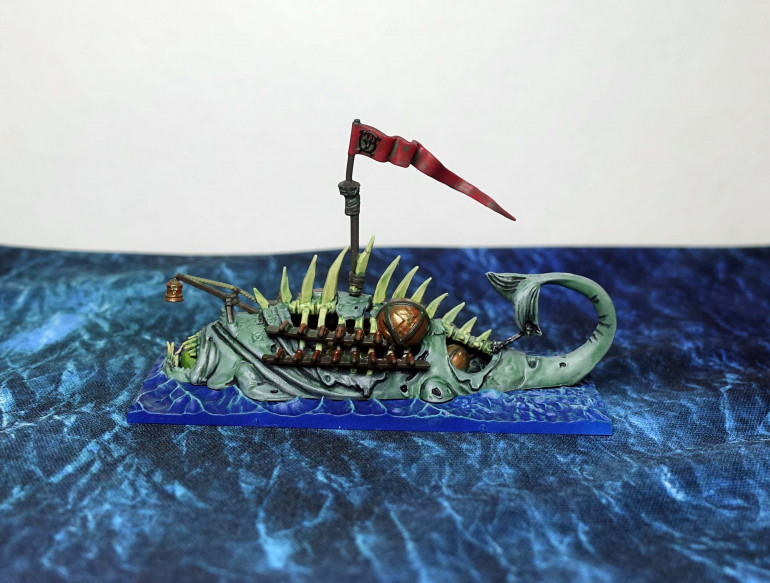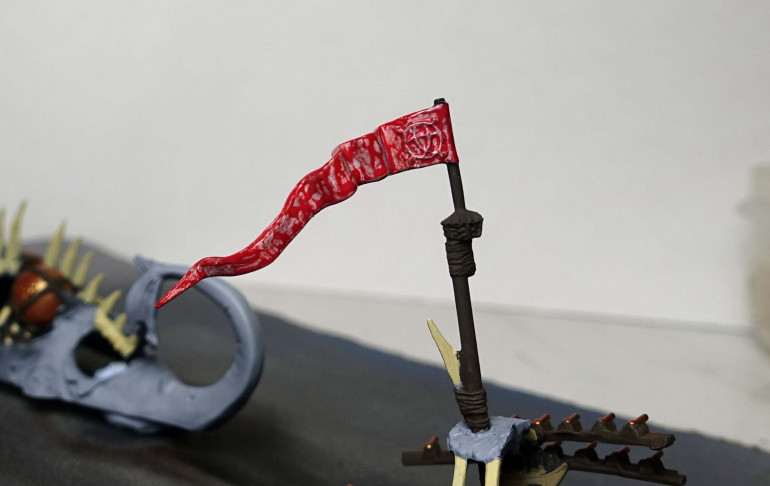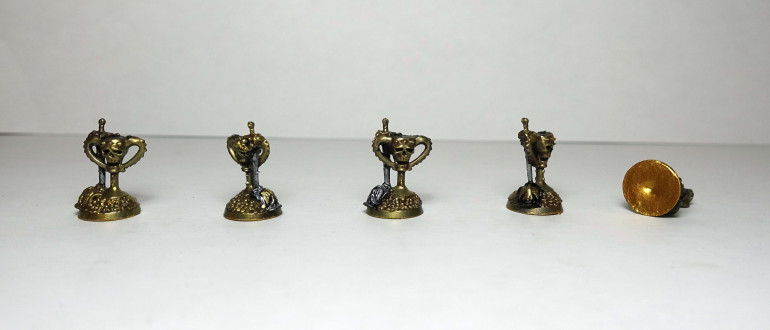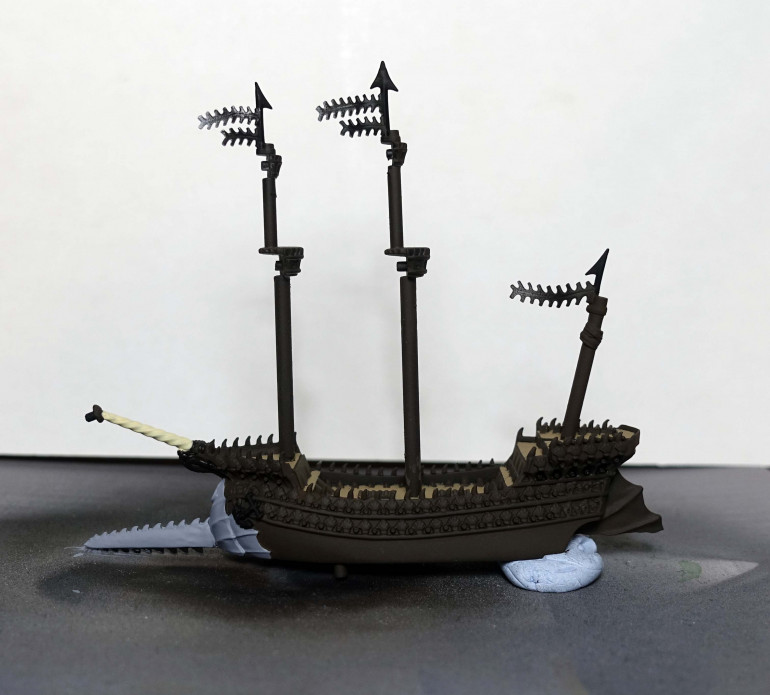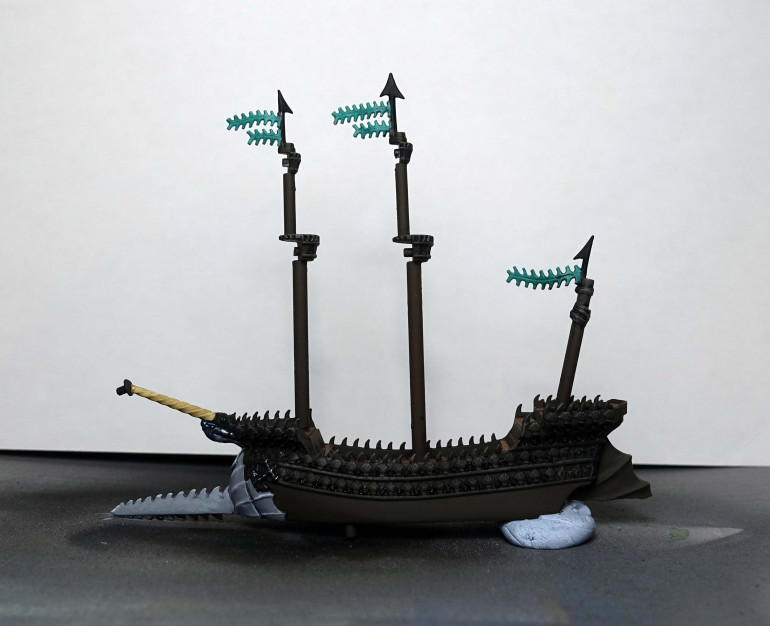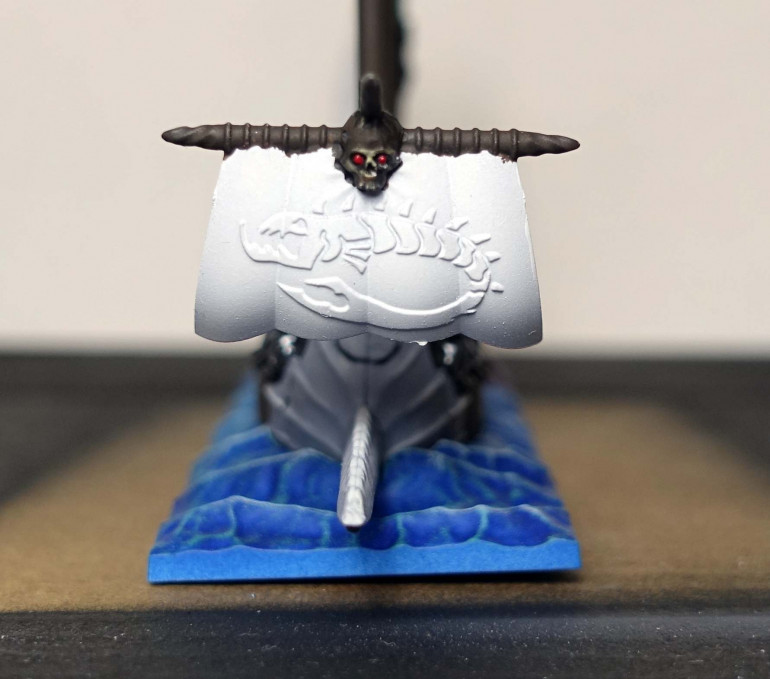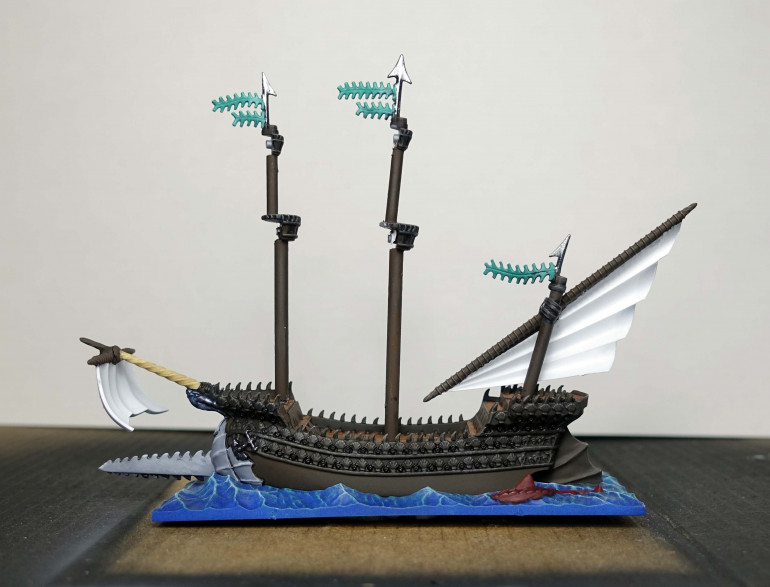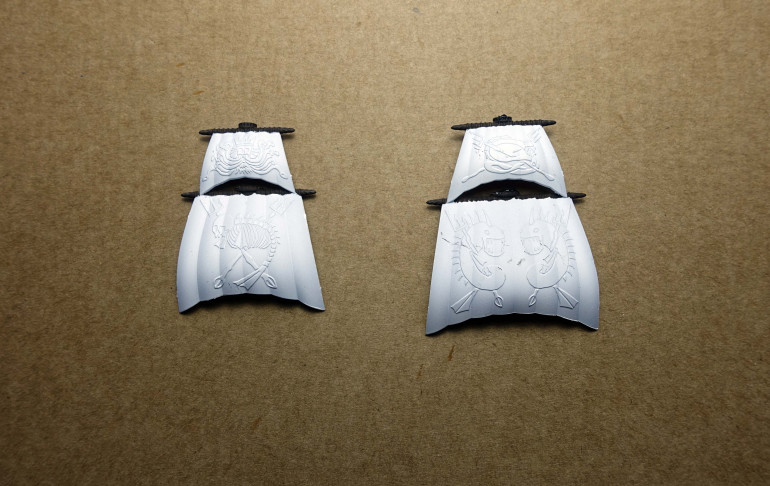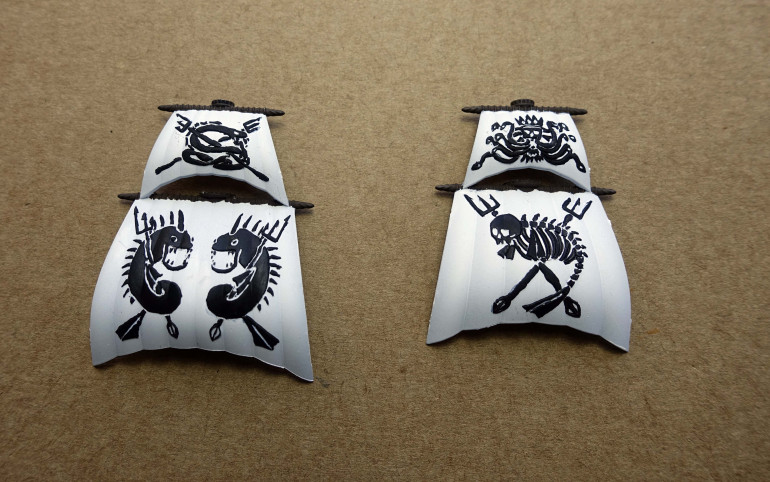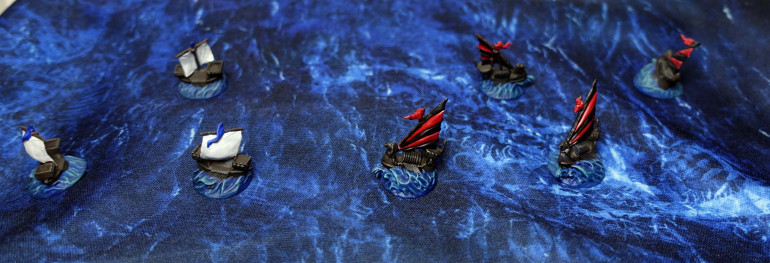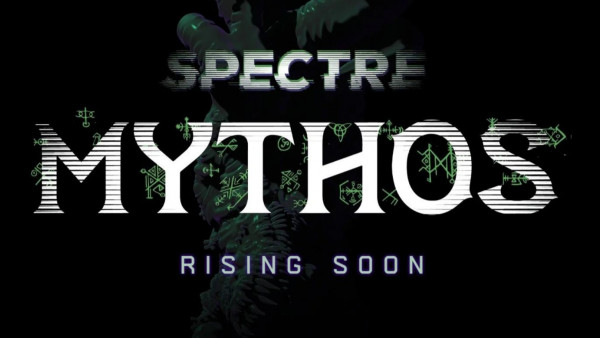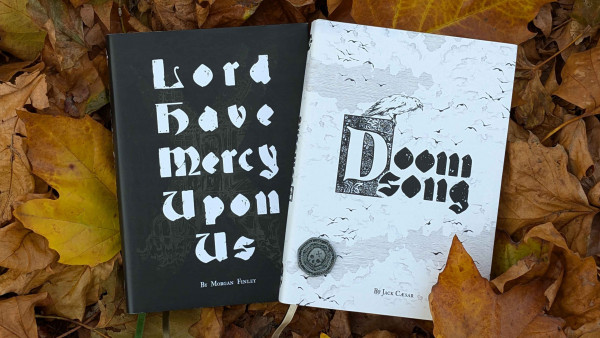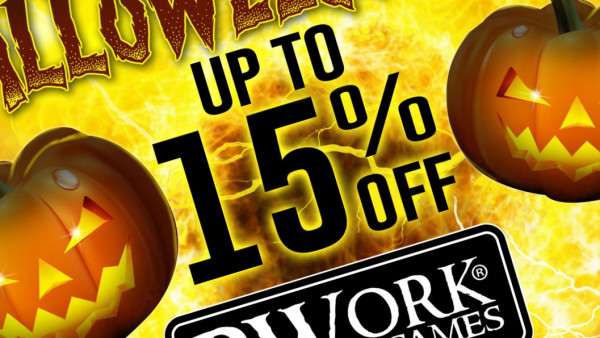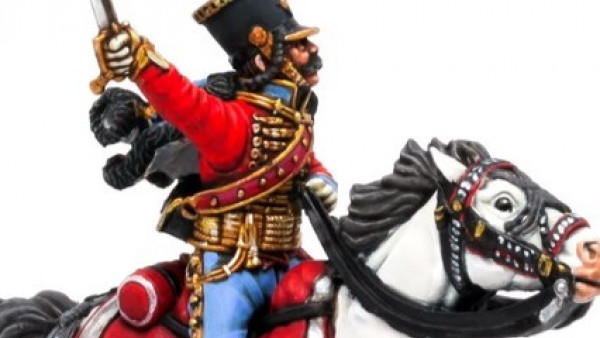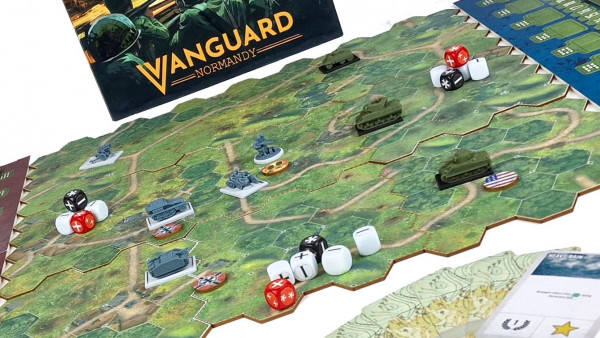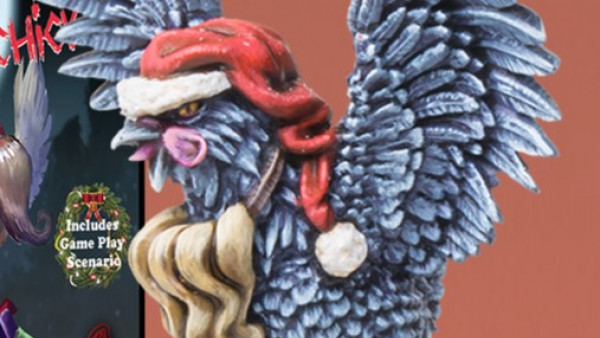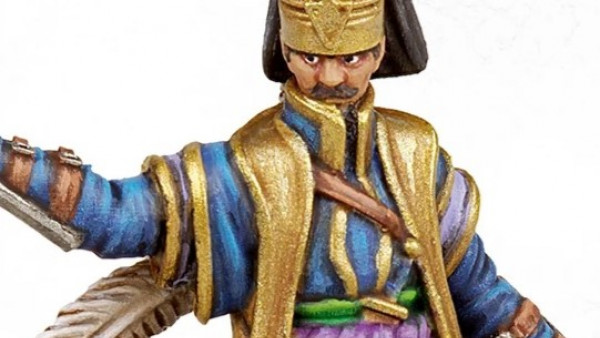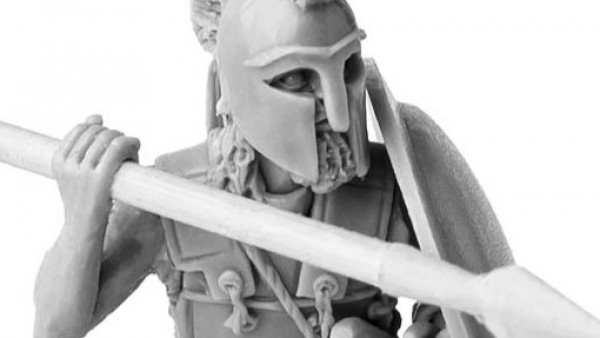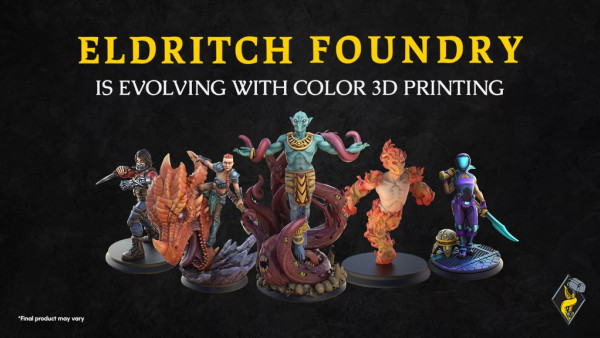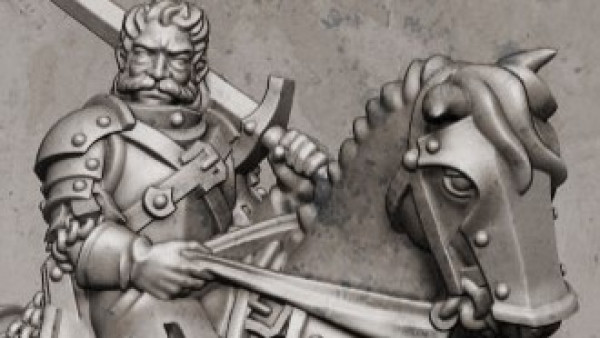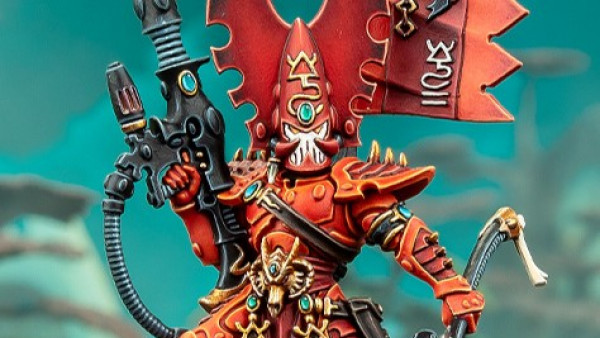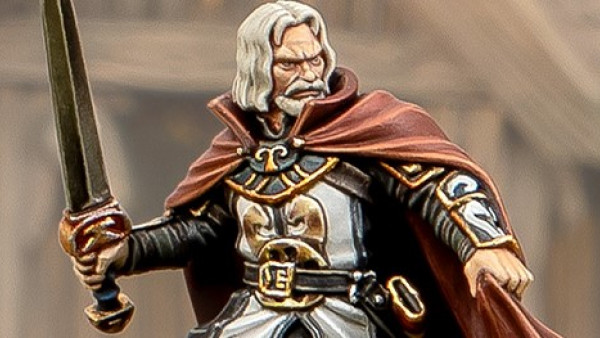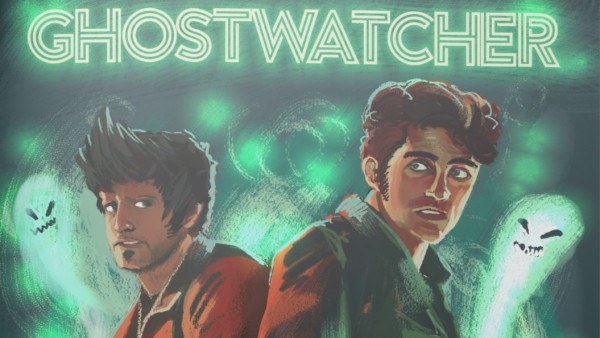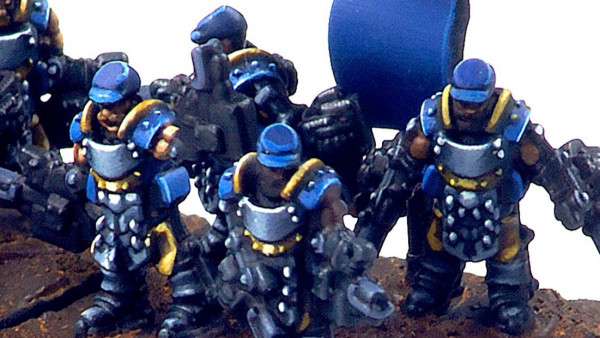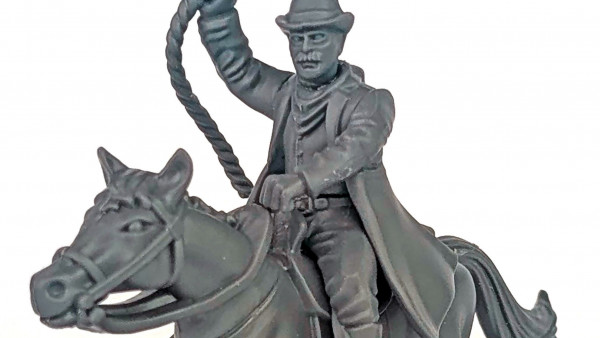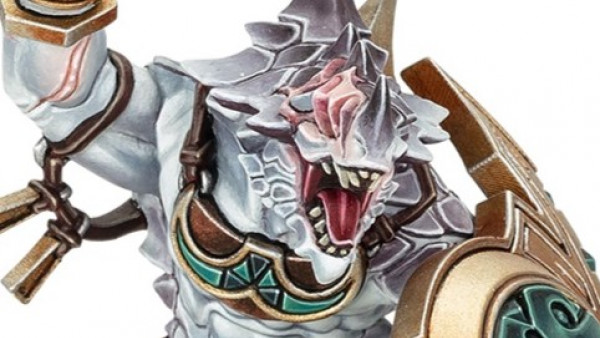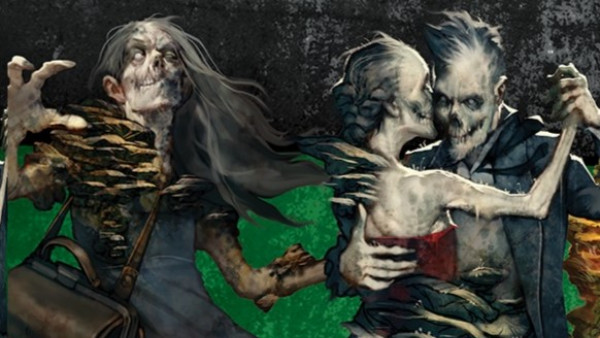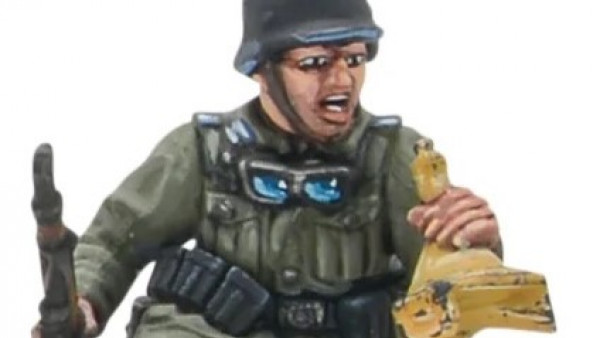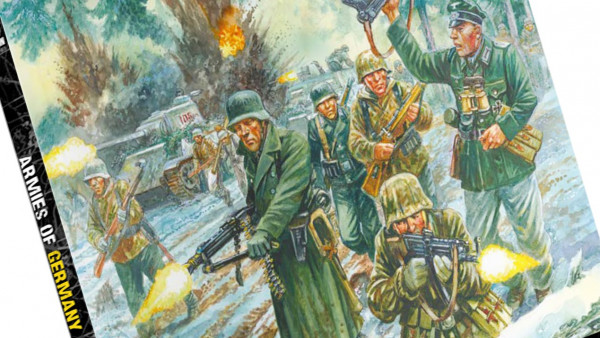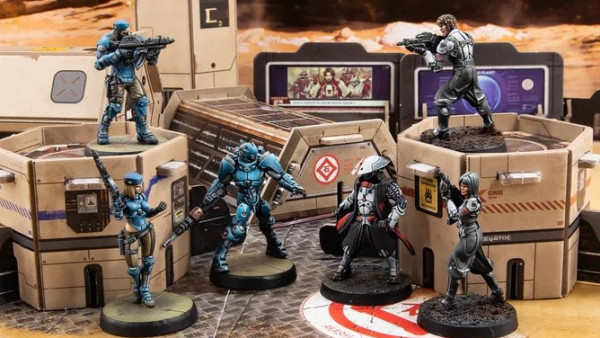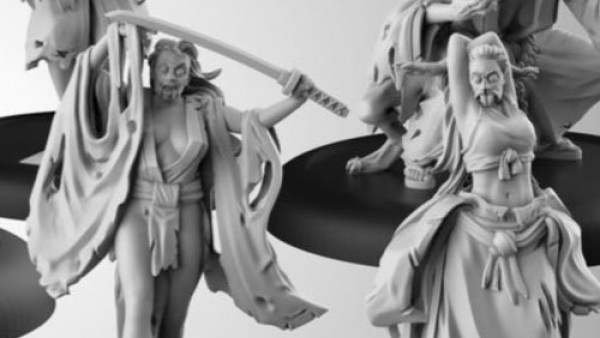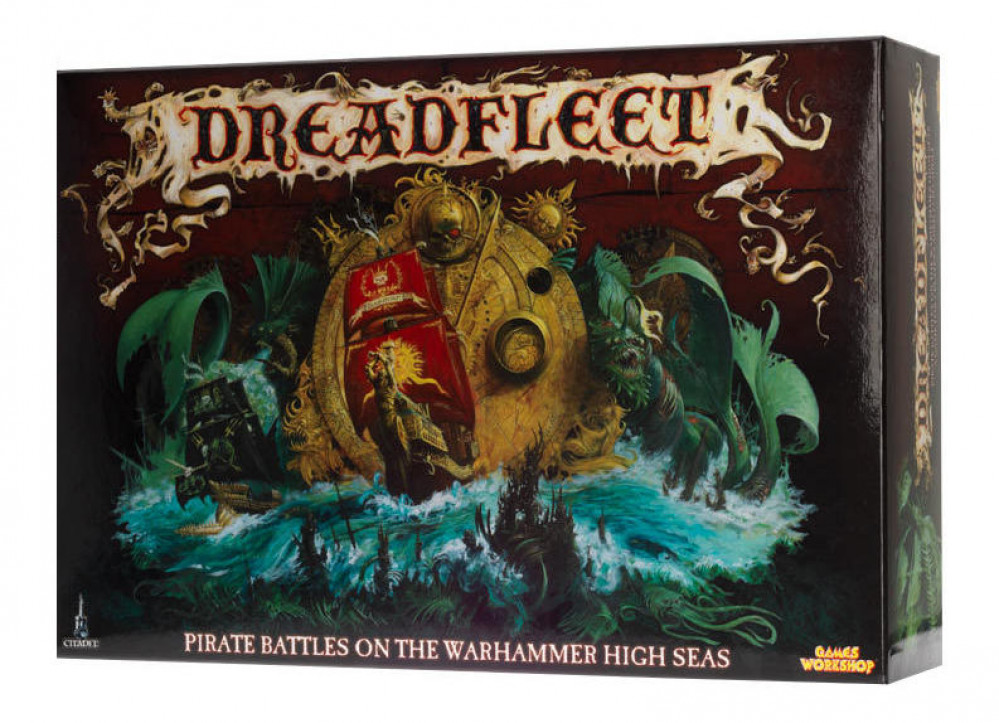
Painting dreadfleet
Recommendations: 518
About the Project
The goal of this project is to paint everything that came in the box: ships, terrain, tokens, sea monsters,...
Related Game: Dreadfleet
Related Company: Games Workshop
Related Genre: Fantasy
This Project is Completed
How the project began
I finished painting all my ships for Dystopian Wars and needed a new project. What should I do next? Start a 16th century army with miniatures from Warlord Games? Kill team is popular and looks interesting. A 17th century army in 6 mm from Bachus?
What to do?
I could take that box from Dreadfleet out of my closet, where it has been for a year. The models are nice, the game is fun and I could use the terrain for Dystopian Wars.
So Dreadfleet it is!
The game contains two fleets: pirates and undead. Each fleet has five ships, including a flag ship. I will paint everything: the ships, the terrain and the gaming aids (rulers, tokens,…).
For this project I will paint much with my airbrush. This is an Infinity airbrush from Harder & Steenbeck.
Building the ships and priming
The terrain and gaming aids have been primed on the sprue. The ships have been assembled first, without their sails and bases. The sails and the bases remain on the sprue and will only be added after painting has been completed.
I’ve used white and black surface primer from Vallejo and sprayed it on with my airbrush.
To make it easier to see which ship is on which side during game play, I will paint the sails of the pirate ships white and those of the undead ships black.
Black:
- Terrain (rocky islands mostly)
- Gaming aids (these will be painted in metallic paint latter)
- Most ships
- The sails of the undead fleet
White
- The sails of the pirate ships
- The elven ship and the flying ghost ship
- The sea monsters
- Superstructure and wind blown by a spirit, both from the Flaming Scimitar
- The bases of the ships. (White is better to achieve a nice bright blue latter)
- The cogs (small auxiliary ships; primed white to achieve bright blue sea water, just like the ships bases)
Airbrushing metallic paints
I love metallic paints. I have a large collections of them and have used them extensively ever since I started painting miniatures. Metallic paints are user friendly. It doesn’t require advanced painting skills to get a good looking result.
I followed the following steps:
- Prime black
- Base coat Plate Mail Metal from The Army Painter. I added some airbrush flow improver, because this paint isn’t made for airbrushing.
- Airbrush with the metallic paint in the colour you want. In my case:
- Model Air Bright Brass from Vallejo for the gaming aids.
- Model Color Copper from Vallejo (mixed with airbrush flow improver) for the Chaos Dwarf submarine.
For the dwarven steamship I stopped after step 2: Plate Mail Metal. I will detail and highlight the ship in a later phase with a brush. The Chaos Dwarf submarine also needs further brushwork now that it’s painted in copper.
I’m not sure about the gaming aids yet. Maybe I’l drybrush them a bit with a lighter shade of gold or keep them as they are. Then all they need is a coat of gloss varnish.
The technique to put on iron or silver paint first and gold or copper on top, I learned from the 3 Colours up tutorials from Beasts of War. It makes the gold or copper look brighter, than when painting directly on black or brown paint. This is the tutorial: https://youtu.be/EDR6by-h2k8
Painting rocks
Dreadfleet comes with a lot of terrain pieces. The larger pieces are islands consisting of rocks. The smaller pieces are shipwrecks with a few small rocks. For all the rocks I used the same process.
I primed them black, than sprayed model air concrete from Vallejo on top as a base coat. The concrete covers the rock entirely. Only in the deepest recesses some black primer may be left.
For the next step I used model air light grey from Vallejo. I tried to achieve the impression of rocks lit from above, so I sprayed from above or under an angle, mostly at the top of the rocks and less towards the bottom.
I used Vallejo Model Wash Dark Grey for the next step. Admittedly, I’m not good at using washes. I tried to pinwash, but the effect is a bit to rough for my taste. Messing with adding water didn’t help much. I should really watch a good tutorial on using washes.
Over to dry brushing: first light grey again. The same colour I used when airbrushing. Here I went over all the edges to make them stand out more. It makes the rocks more three-dimensional. I dry brushed more towards the top of the rocks and less towards the bottom. Next: white grey from Vallejo. I dry brushed this colour only on the upper parts of each rock. The result looked good, but I wasn’t entirely happy yet. For a final highlight I dry brushed the top of the rocks and the sharpest edges with white.
While dry brushing I dry brushed heavier on the stairs that some of the islands have and on the skulls on all the islands. Games Workshop isn’t Games Workshop without skulls everywhere. ?
The volcano
The Volcano was a special case. Beside the steps above I airbrushed the lava white with Model Air White from Vallejo. On top of the white I airbrushed Airbrush Pro-Color Canary yellow. (Not the most common brand of paint among wargamers, but t happened to be the closest yellow at hand.). Dry brushing with orange didn’t give the desired result. So I painted orange on the edges of the lava with a brush. The orange is orange red from Vallejo.
I’m finished painting all the rocks. Painting all the buildings and other details on the terrain pieces will be for another entry. 🙂
To paint the sea
Its been a while since my last update, but I have kept painting in the meantime.
The bases of the ships consist of sea surface. The miniatures of the cogs, sea monsters and the smaller terrain pieces contain sea as well. Here I only describe the bases, but I’ve followed the same steps for the other pieces containing sea.
To begin with, I primed the bases in white. I left the bases on the sprue for priming, but the result isn’t what it should be. I removed the bases from the sprue and gave them another layer of white primer.
The next step was to base coat them blue. The game comes with a gaming math in a nice saturated, dark blue. I want the bases of my ships to look similar. The goal is for the sea to have a “painted look”, like you’ld see on a painting. Not so much a realistic look.
The bases were airbrushed with Model Air Blue “Blue Angels” from Vallejo Model Air. Then they were dry brushed thoroughly with Jade Green (Game Color from Vallejo). For the second layer of dry brushing I dry brushed the raised areas with blue green (Model Color). Finally the most raised areas and the peaks of the waves where dry brushed with pale blue (Model Color).
The result looks nice. While working on the bases as well as on the rocks, I noticed dry brushing gives a really good result after the third layer of (different) paint.
With the sea painted, many details still need to be done. Each base has details that reflect the ship it’s for: the dwarf battleship has a little steam boot on it’s base, the elven ship has dolphins accompanying it,…
Painting the details will be for another time.
Gold
On to something completely different: I still had to varnish my golden gaming aids. At the store I asked for the glossiest gloss varnish they had. They recommended gloss topcoat from Mr. Hobby. This is the result. Some very shiny golden gaming aids. 🙂
The castle
The castle is the largest terrain piece in the box. It could be considerd a centre piece, so it deserved some extra attention. The rocks on which the castle is build, have already been painted, as you could read in my earlier entry about painting rocks. At the time I had no idea how to paint the castle itself. The overspray from painting the rocks, had already given the castle walls a dark grey look. Darker then the rocks. I liked the look of the walls. A bit of dry brushing and they’d be finished. Only the two towers at the centre of the castle were still only covered in black primer.
I gave the towers a base coat in model air concrete from Vallejo. The same colour I’ve used to basecoat the rocks. It took many, many layers to base coat the towers and get rid of the brush strokes. The next step was a black wash and many more coats of model air concrete. (I’m still not good at using washes. For others with this problem. A video with Sam Lenz has just been released by Tabletop Minions about using washes: https://youtu.be/PAKvwVSKqWI) A thorough dry brush with model color light grey followed.
Up until this point I followed the same steps I’ve used to paint the rocks. But I don’t want the castle to look like the rocks. For the following steps I’ve used different paints to create a difference in the look of the rocks and the look of the castle. I started dry brushing the castle walls and the two towers with Model Color “Blue Blue Pale” and a second final dry brush wit Model Color “Pale Blue” (both Vallejo).
The names are very similar, but they are very different paints. (Possibly the names weren’t translated correctly from Spanish.) Blue blue pale is more blue, where as pale blue is more green. These two colours gave the castle a more blueish/greenish grey look, while the rocks are neutral grey.
Now the roofs of the castle needed to be painted. For a ceramic look I base coated them with Panzer Aces Light Rust and then dry brushed them with Panzer Aces Yellowish Rust. Both from Vallejo.
Finally I wanted more earth looking surfaces on the ground within the castle. I’ve experimented with some browns, but perhaps this wasn’t such a good idea.
Now I could finish the castle with a coat of matt varnish, using the cans from The Army Painter. This is the varnish I will use for almost everything in this project.
I’ve finished the volcano and another large island as well. After varnishing I’ve put some semigloss varnish on the lava, to make it look more realistic.
My largest terrain pieces have been finished!
The Black Kraken
For the first time since the start of this project on a naval game: an entry about painting a ship!
The Black Kraken had been base coated in copper in my earlier entry about airbrushing metallic paint. Vallejo Model Color copper is an interesting paint. It’s red with a golden shine. An unusual and very good looking metallic paint.
To whether the ship I bought Nihilakh Oxide from Citadels range of technical paints. It’s the first time I use it. I was looking forward to trying it out, which is why I painted this ship first.
The question was how to use the oxide paint? Strait from the pot? Thinned with water to be used like a wash? If you read my previous entries, you may have noticed I struggle with washes. Eventually I experimented with painting from the pot for the deeper recesses for a heavier oxidized effect and a wash over the surfaces. The paint doesn’t need much water. It’s more liquid than ordinary paint. I can recommend this paint. Its user friendly a gave a nice effect.
Normally I begin to dry brush the model at this stage to make it more three-dimensional and make it look as if the light comes from above. This time I didn’t. I fear dry brushing will undo or diminish the oxide effect. The only dry brushing was with Vallejo Model Color Natural Steel followed by The Army Painter Plate Mail Metal on the tips of the tentacles and the tip of the drill at the back of the ship. This makes those tips look harder, sharper and more threatening.
The water was painted in the usual style as described in my entry about painting the sea. Finally the “eyes” of the ship were painted black. I finished my first ship from Dreadfleet!
PS: I found another project about Dreadfleet on Beasts of War. The ships are painted beautifully by horus500: https://www.beastsofwar.com/project-entry/1262554/
Turtle island, varnishing and storage
Turtle island
I’m not quite finished painting large islands just yet. There is an island in the shape of the skeleton of a turtle, with a castle build on top. I wanted this castle to look different from the other, bigger castle. This castle I wanted to look like it was built with bricks. In previous projects I’ve been searching for a good “brick red” to paint walls, but I haven’t found one yet. This time I’ve used burnt red from Vallejo. The result is a nice dark red castle, but it’s not the colour of bricks.
For the planks on which the castle is build, I used old wood (Vallejo panzer aces). The poles on which the planks and castle rest are painted in chocolate brown. This colour came with a set of paints I bought from Vallejo named “Wood & Leather”. I’ll be trying out several other paints from this set painting shipwrecks, ships and other wooden parts. Next I used orange brown (also from this set) with much water added as a wash over the planks. Almost no effect. A chocolate brown wash than: better, but still not perfect. Eventually I took some black paint and painted the lines between the planks black with a fine brush. Finally the wooden parts received a dry brush with Japanese uniform WWII from Vallejo model color. Not a paint you’d expect in this project. It came with the Wood & leather set. When dry brushed over chocolate brown, it does give a wooden look.
For the castle I pin washed the recesses with black wash. The castle was then dry brushed with orange brown. I used this colour to ty it in with the wood, which received a wash with the same colour. The roof was painted black an then dry brushed blue blue pale from Vallejo.
The sea and rocks had already been painted following the methods described in earlier entries.
Varnishing the Black Kraken
I didn’t expect to write about this ship again, as it seemed finished. After painting I sprayed matt varnish from The Army Painter on the ship. The result wasn’t quiet what I wanted. I should have thought about this beforehand: a ship painted completely in metallics shouldn’t be varnished with matt varnish. It doesn’t look right. To make it shinier, but not to shiny (because it’s old oxidized copper, not brand new copper), I’ve brushed satin varnish from Vallejo on the ship. The base and water dripping from the ship were left matt. Finally I brushed gloss varnish over the edges of the tips of the tentacles and the tip of the drill. This was done carefully over the edges only. It makes those tips look sharper.
To store a Dreadfleet
Since I began this project I’ve wondered how to store and transport these miniatures ones they will all have been painted. Battle foam sells foam inserts that fit in the original box and can hold all the ships, terrain pieces, gaming aids, cards,… They call it ”sea fleet”: https://uk.battlefoam.com/game-box-sea-fleet-foam-kit/
This is what I bought for my miniatures. The foam arrived in less than a week after ordering from their website.
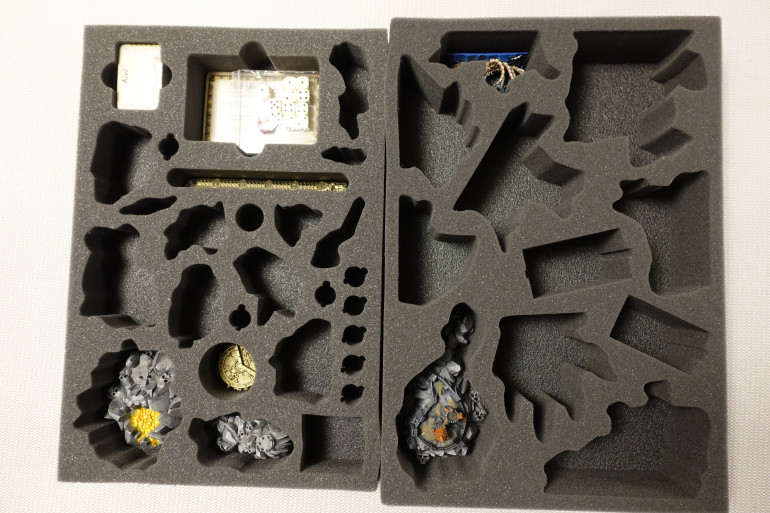 This is what the foams look like. It also shows how much I still have to paint before this project will be finished... :-)
This is what the foams look like. It also shows how much I still have to paint before this project will be finished... :-)Alternative storage sollutions:
Battle foam makes another set for “sea fleet” that fit’s in the bags they sell to transport miniatures: https://uk.battlefoam.com/battle-foam-sea-fleet-foam-tray-kit-for-the-p-a-c-k-system-bags-bfl/
KR Multicase also has foam trays that fit in their boxes to store miniatures: https://www.krmulticase.com/product/traysets/WHBOX-DFL-A
Base coating the ships
The sails
Base coating the sails and hulls was done by airbrush.
Sails of the pirate ships: after priming with white surface primer, I’ve base coated whit Model Air white. This is a brighter white than the primer. It makes the sails looks nicer and covers any remaining bare plastic.
Sails of the undead ships: their black primer serves as base coat.
The hulls
The pirate flagship and The Swordfish were base coated in Model Color Chocolate Brown from Vallejo. For the Flaming Scimitar I used Model Color Wood Grain from Vallejo. This is a more red brown, but on a black undercoat, there’s hardly any visible difference. I added airbrush flow improver for both.
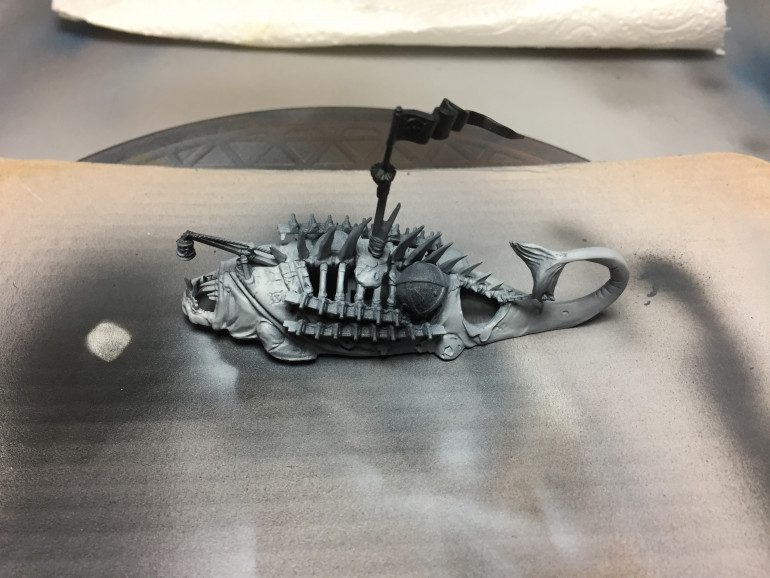 Skabrus received a base coat in Model Air Light Grey to make the body of the ship look like decaying or dead flesh.
Skabrus received a base coat in Model Air Light Grey to make the body of the ship look like decaying or dead flesh.The decks
The decks of the ships will be base coated with a brush, as well as some other parts requiring a different colour base coat. For example: the roofs of the Heldenhammer on the photo bellow, painted in Model Color dark red. Vallejo’s Dark Red looks a bit, well, … I won’t say purple, but not so very red. I intend to alter the colour a bit through washes and dry brushing in a later stage.
The deck of Heldenhammer was base coated with Old Wood from the Panzer Aces Range. The figurehead was base coated black to use metallic paints on it in the future. At the moment I don’t intend to use much metallics or other colours on the ship to preserve the look of a wooden ship.
The flags are base coated white. In a later stages I want the colours I will paint the flags in, to look bright.
Wrecks and islands
Dreadfleet comes with several small terrain pieces. The rocks and sea have been painted following the same methods described in previous entries.
Wooden wrecks
To paint the wooden wrecks:
- Bade coat: Model Color chocolate brown
- Wash: Vallejo black wash
- Dry brushing:
- Model Color orange brown
- Model Color Japanese uniform WWII
- Model Color dark sand
This project was an opportunity to try out Vallejo’s wood & leather paint set. When I bought it, the colours surprised me a bit. After testing, I conclude the lighter colours in the set complement a chocolate brown base coat very well and the this combination of colours succeeds at creating a wooden look. I can recommend this paint set to create the look of wood. In a future project, I will try out painting leather with this set.
The smallest terrain pieces contain a mast with a flag on top. I painted these red and green.
Green flags
Base coat: Model Color Medium Olive
Wash in the fold of the flag: black wash
The round, outer parts of the flag: dry brushed heavily with Model Color Lime Green, followed by a final dry brush of pale blue. Pale blue was perhaps not the best colour for this, but it was what I had available.
This made the flags look lively.
Red flags
Base coat: Model Color Carmine Red
Wash in the fold of the flag: black wash
The round, outer parts of the flag: dry brushed with Model Color Lime Orange Red.
The carmine red was surprisingly glossy, but this will disappear after varnishing with math varnish.
The heavy dry brushing on the flags makes them look more lively. I must remember this when painting the flags of the ships.
The sails
Painting the sails was problematic. The terrain pieces were primed black, which was the suitable primer colour for the rocks, the sea and the wrecks. Not for white sails. I brushed several layers of white primer over the black primer. Eventually I switched from primer to Model Color White. Brush strokes remained visible and the overall appearance of the sails was to rough for sails. I tried to give some shading with:
- Black wash. Bad idea!
- Washes with watered down paint of light browns. Not great.
- Game Wash Sepia Shade. Hmm, still not great, but I wanted to try out this wash out because I just bought it.
After much experimenting and a final white highlight/reparation attempts I consider the sails “good enough”. I don’t think I can get them any better and I want to move on to painting ships.
Perhaps I should have painted coats of grey paint over the black primer, starting with dark grey and building up to light grey to end with white.
Well, they were supposed to look like sails from ships that wrecked long ago. The definitely look weathered!
The Heldenhammer – Part 1 The hull, the superstructure and the roofs
The flagship of the pirate fleet!
(I’ve got more text and photos than the projectsystem can handle. My entry about the heldenhammer will come in several parts.)
Washes
Base coating was described in an earlier post, so we will move on to using washes. I used Vallejo’s black wash over the entire surface with an chocolate brown base coat.
On the deck I first used a wash of watered down Model Color Orange Brown. Once dry the wash was invisible. This paint isn’t dark enough for a wash on old wood, it seems. Next wash: watered down Model Color Chocolate Brown: this looks good.
Lastly I’ve put a wash of Model Color Smoke on the deck. Smoke is a colour I haven’t used before. The last colour I hadn’t used from Vallejo’s Wood & Leather paint set. In the bottle the paint looks very dark. Almost black. I expected a transparent black paint, because a paint from another brand named “smoke” is a transparent, slightly brown, black paint. Smoke turns out to be brown paint. Compared to chocolate brown it is more transparent and perhaps a bit more red. On the photo below I compare the two.
I used watered down smoke for the final wash on the planks.
Black shadows
The black wash on the hull didn’t create dark enough shadows. I used a brush with a fine point to paint shadows with black paint. To do this for every detail on the ship would take for ever, so I only painted the shadows around the sculptures on the ship to make them stand out more. The doors and windows were also painted black (mostly in the superstructure at the back of the ship). To accentuate a few clearly visible lines, I used black as well. Such as the lines separating the lowest line of guns and the clean hull at the bottom of the ship. I also painted a very thin black line where the red of the roof touches the brown of the superstructure.
Returning to the base colour
Here and there painted chocolate brown again on parts of the ship I want to have a more clean look.
Dry brushing
I like the chocolate brown colour, so I didn’t dry brush too much.
The red roofs received a dry brush with Model Color Carmine Red. The result wasn’t quite what I wanted yet, so another dry brush with Model Air Italian Red followed. The roof is a little bit more red now. A very little bit. For a more red roof, I should have used a different base coat.
The Heldenhammer – Part 2 The figurehead and the details
The figurehead
The figurehead is hard to miss on this ship. It’s a big statue of a man holding a huge hammer. In the game this hammer is used to hit enemy ships with. I will paint the figurehead to look like a bronze statue. Not to lose any details on this statue, I thinned my paints sufficiently on a wet pallet.
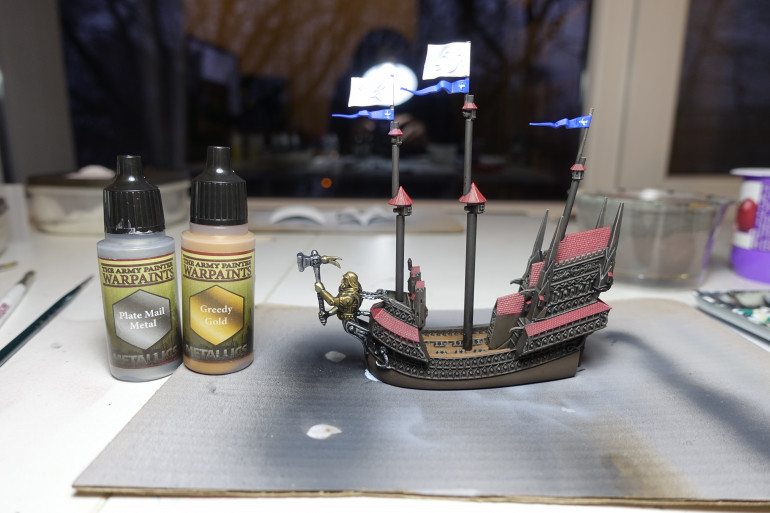 Step 4: Dry brush the statue with The Army Painter Greedy Gold. And step 5: Edge highlight the hammer with The Army Painter Plate Mail Metal. Finished!
Step 4: Dry brush the statue with The Army Painter Greedy Gold. And step 5: Edge highlight the hammer with The Army Painter Plate Mail Metal. Finished!The details
This ship contains so many details a perfectionist could spend a lifetime painting them. I won’t paint the sculptures on the ship. It takes too much time and I want to preserve the look of a wooden ship.
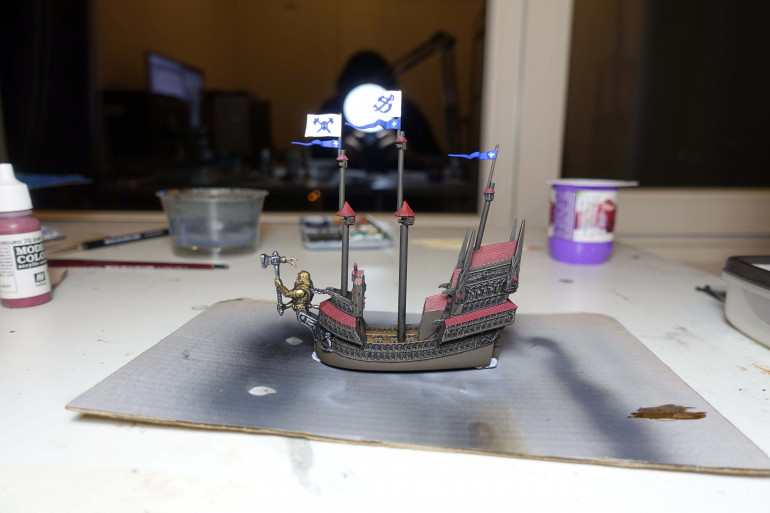 I did paint all the cannons black. Those on the deck as well as those sticking out of the beam and stern.
I did paint all the cannons black. Those on the deck as well as those sticking out of the beam and stern. 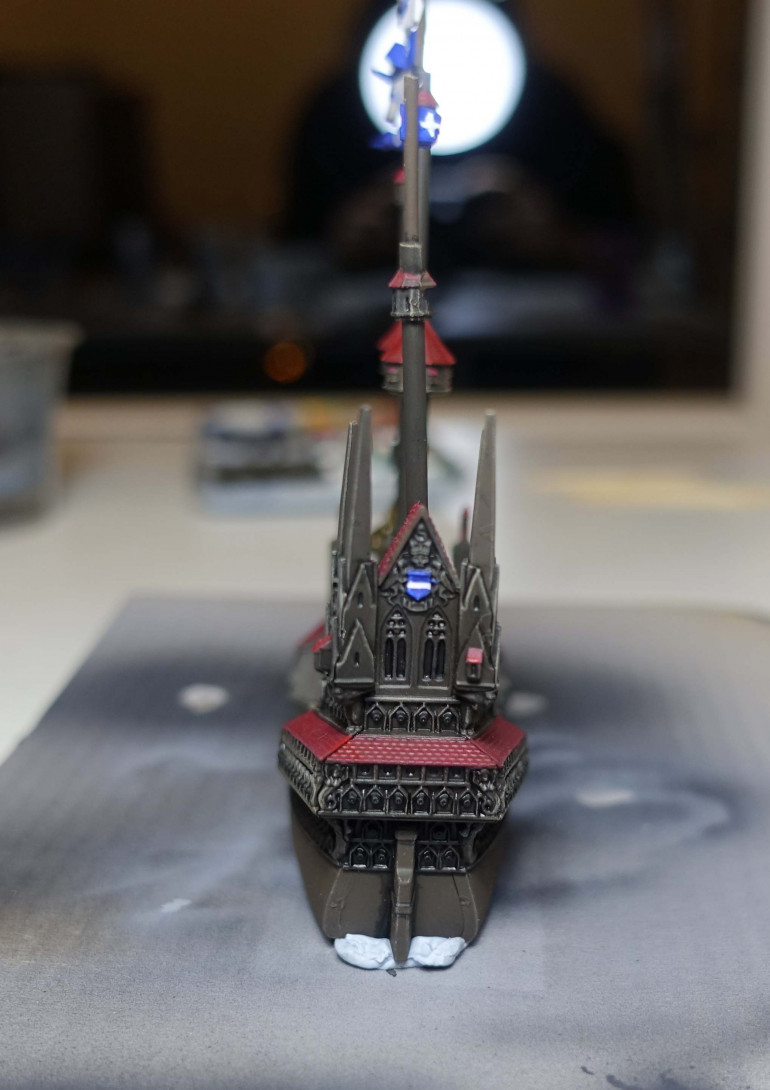 The decorations on the stern contain a (relatively) large shield. I painted it in blue and white, to correspond with the flags and sails.
The decorations on the stern contain a (relatively) large shield. I painted it in blue and white, to correspond with the flags and sails.The base
Painting the water on the base had been done earlier. You can read about it in my entry “To paint the sea”.
The base of each ship contains extra details. The base of the Heldenhammer contains a small cog. I painted it with the same colours as the hull of the Heldenhammer to make them look harmonious. The oars are painted in Panzer Aces New Wood. I made use of the opportunity to paint some details on het bases of other ships as well, while I had the right paint on my brush.
This entry will be followed up by part three about the sails and flags of the Heldenhammer, once I’ve finished them.
The Heldenhammer – Part 3: Flags and sails
After the sails on the terrain pieces, I wasn’t looking forward to painting the sails on the Heldenhammer. This time I have no black primer to fight, but it will be tricky to get a good result. My initial plan was to leave the sails white. But since this is a flagship and the sails will draw the attention on the finished model, I will try to paint them. The images on the sails will be painted in Model Color Blue, while the rest of the sails remain white. No other colours will be used.
Some brown paint from the spar (let’s hope this is the correct naval term) ended up on the sail. With thinned down white paint, I’ve started to remove these brown stains. Watered down to prevent a thick layer of paint remaining on the sail. That would certainly look bad.
For the images on the sails I suspect the best way to paint them is with several thin coats. As thin as possible. I struggled a bit with thinning the paint on my wet pallet. Sometimes it turned into a blue wash instead of thinned paint.
To get the best result, the sides of the raised images should be painted blue systematically. The surface of these sides narrow. Painting them requires much caution and patience. I’m not a patient man. I switched to a smaller brush to paint such small details: 4/0. It takes forever to paint with such a small brush.
The two big flags will remain white with the images in blue, just like the sails. The three small flags are painted in reverse: blue flags with a small white cross.
Having painted the main surfaces of the images white, I encountered the following problem: sometimes two blue surfaces touch each other. The line separating them is invisible. Surfaces of the images left white (eg. the big hammer) touch each other as well or they touch the white sail and the line separating them, is invisible too. To resolve this I used blue ink (Vallejo Game Ink) where two white surfaces meat and black wash (Vallejo Game Color Wash) where two blue surfaces meat. The ink worked very well. The blue paint and blue ink are a very similar blue.
After much more finalising and correcting the sails and flags are done. They are not as good as I’ld like. The sails look as if painted at a lower level of quality than the rest of the ship. I’m affraid it takes someone with better painting skills to achieve a better result.
Cannons
Finally I’ve put a little Plate Mail Metal from The Army Painter on the cannons. The black cannons were almost unnoticeable otherwise. They stand out a bit more now.
This ship has a lot of cannons. I’m looking forward to firing them!
Lessons learned
- My sails aren’t white enough. I will give the sails of the other ships an extra coat of white paint.
- The masts hinder painting the ships. I should have glued them in place after painting the ships. Painting the elven ship I’m working on at the moment, I’ve noticed the same problem.
One last thing
Look what I found on YouTube! A cracking unboxing of Dreadfleet!
Grimnir’s Thunder
This dwarven battleship was base coated Plate Mail Metal (The Army Painter) earlier. Several details were painted in Model Color Bronze. I didn’t paint to many details in bronze to maintain the look of a steel ship. Then black paint and Game Color Black Wash was used for the recesses. All the cannons were painted black.
A dry brush with Plate Mail Metal followed and the occasional edge highlight with the same paint where necessary. The runes in bronze received a second coat of bronze paint. The dry brushing had made much of the bronze paint disappear.
The balloon coming with the ship, was painted following the same steps. So was the little steamship on the base of Grimnir’s Thunder.
This ship was a fun and quick to paint.
The sunken battleship
The last terrain piece to be painted is a sunken dwarf ship. It looks just like Grimnir’s Thunder. I painted it following the same steps as above. Then I added a few steps to wheater the ship, making it look as if it sank long ago. First I used Vallejo’s Model Wash Brown. This didn’t have to much effect. I switched to pigment powders.
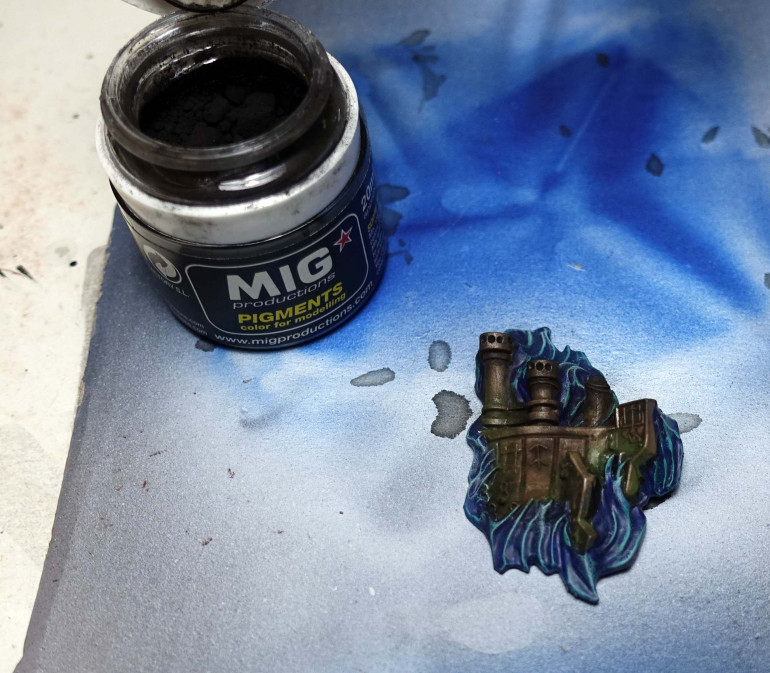 Last pigment powder: Mig Black Smoke. I used this a bit everywhere, but mostly around the top of the chimneys.
Last pigment powder: Mig Black Smoke. I used this a bit everywhere, but mostly around the top of the chimneys.The end result looks very different from the clean and shiny Grimnir’s Thunder. I don’t think the same result can be achieved with paint and certainly not in such a short time. Wheatering with pigment powder was done in a matter of minutes and is very easy to do. The trick to good results with pigment powders, is to use several colours on top of each other.
Seadrake
For the Seadrake white and blue will be the dominant colours. Besides looking coherent with the Heldenhammer, they are two typical High Elf colours. I’ve used these two colours to paint my High Elf army for Warhammer Fantasy as well.
Base coat
For base coating I’ve used these paints:
- Panzer Aces New Wood: the deck. A slightly darker brown than on the other ships to contrast more with the white hull.
- Black: figurehead. I will use metallic paints on it later.
- Model Color Blue: roofs.
- Model Color Medium Olive: dragons!
Washes
- Model Color Wood Grain: watered down to use as a wash for the deck.
- Game Color Wash Blue: the roofs.
- Game Color Wash Green: the dragons.
The blue en green washes weren’t dark enough, so I mixed them with black wash from Game Color.
Figurehead
After the black undercoat:
- The Army Painter Plate Mail Metal
- The Army Painter Greedy Gold. This took several layers. I’m used to airbrushing metallics and didn’t expect it to be this difficult to paint gold over plate mail metal.
- Highlighting the gold: first Model Air Bright Brass. Dry brushing followed by some edge highlighting. I wasn’t happy with the result and highlighted again with Model Color Gold.
- Model Color Carmine Red: tongue and eyes. I painted the eyes and tongue white first, to make the red “pop” more. The tongue received an extra layer of Model Air Italian Red for a very red red.
- The ram received a highlight in Model Air Chrome.
Dragons!
A historical moment in my life as a wargamer: for the first time since I started painting miniatures nineteen years ago, I’ve painted a dragon! I thought they’d be taller. ?
High elf dragons are typically painted white and blue. Because there is so much white and blue already on this ship, I choose green. This contrasts a bit with the rest of the ship.
After the wash:
- Dry brush Model Color Medium Olive
- Dry brush Model Color Lime Green
- Eyes: white followed by Model Color Carmine Red
- The talon on top of the wings: Model Color Dark Sand followed by white.
Roofs
It turns out I have no light blue in my collection of paints. So I mixed Model Color Blue with white on my wet pallet. Professional painters often do this in tutorials, but it’s not something I’ve often done before. Perhaps something to try out more in the future.
The roofs were dry brushed with this freshly mixed light blue.
Flags and sails
I kept the flags and sails white. The white flags contrast nicely with the blue roofs.
For the sails: I’m afraid it will take me a lot of time to achieve a mediocre result if I try to paint them. So I kept them white. I did airbrush a extra coat of white paint on the sails to create a more clean, more white look. And give the sails of the other ships I haven’t finished yet, an extra coat of white paint as well.
The end of the spars, sticking out from behind the sails, were painted Panzer Aces New Wood, just like the deck.
Bolt throwers
Bolt throwers are an iconic weapon of the High Elves. After painting them in Model Color Chocolate Brown, they didn’t look right. I’ve tried to gently dry brush them with Model Color Dark Sand. That didn’t resolve it and I can’t dry brush the bolt throwers sticking out of the side of the hull and the masts. (Look at the photo! There are bolt throwers sticking out of the top of the mast, just below the blue roofs.) As a finishing touch I’ve painted the bolts laying on top of the bolt throwers in Dark Sand. This looks better.
Dolphins!
I almost forgot there were three dolphins on the base. I’ve painted these in Model Color Light Grey. Then a light wash (1/4 blue wash, 3/4 water).
Varnishing
As usual I’ve sprayed matt varnish with a can from The Army Painter over the ship and the dragon. The ship parts in metallic paint received a coat of gloss varnish. Both dragons a coat of satin varnish. Finally I gave the white hull a coat of gloss varnish as well.
I added water to the varnish because Vallejo recommends this in their tutorials, but the gloss varnish isn’t very glossy any more after watering it down. The parts with gloss varnish received a second coat with pure varnish.
General comment
Scale modelers who build and paint ships, tend to paint the parts first and then assemble the ship. For Dreadfleet, there is something to be said for this approach. Once again the masts were a hindrance while painting. Painting this ship took much correcting where my brush had accidentally touched the wrong part of the ship.
The Skabrus
First entry of the new year! Happy New Year, everyone!
The Skabrus is essentially a big, dead fish repurposed as a ship by the Skaven. I want the ship to look like a dead fish. To achieve this I primed it black and then sprayed light grey over the entire ship, to make it look like dead skin.
While attaching the ship to a piece of cardboard with blu tack the middle section with the guns and the flag came loose. Since experience with the previous ships seemed to indicate it’s easier to paint ships in parts, I painted the to parts separately and glued them together again after they were painted.
Basecoat
For the basecoat of the different parts of the ship I’ve used:
- Model Color Chocolate Brown: the wood and what could be some sort of ropes that keep the ship together.
- Model Color Copper: the bell, the metal balls on the ship and the cannons. The cannons have the shape of Skaven Warp Lightning Cannons. So copper seemed and appropriate colour. (They have the shape of the old models for these cannons: https://www.dakkadakka.com/gallery/172948-Skaven%2C%20Warhammer%20Fantasy%2C%20Warplightning%20Cannon.html)
- Black followed by The Army Painter Plate Mail Metal: the chain at the back of the ship
- Model Color Dark Sand: the skeleton and teeth
- Panzer Aces Old Wood: the rope of the bell and the planks beneath the middle of the ship.
- Grey primer followed by Model Color Carmine Red: the flag.
Wash
The next step was a green wash (Game Color Wash) over the entire model to bind everything together. This ship seems to have more need to be bound together in this way than most ships. First I used a watered down wash. The wash didn’t stay in all the recesses so I gave the entire ship another layer of green wash. Pure this time.
Finalising
Finally I dry brushed light grey on the “hull” of the ship and Dark Sand on the skeleton. The last step was to paint the Skaven symbol on the flag black.
This is the fifth ship I’ve painted from dreadfleet. We’re have way there!
Post Scriptum
I wanted to share the photo bellow with you. I painted grey primer on this flag before switching to red because painting red directly on a black primer didn’t seem like a good idea. One coat of Model Color Carmine Red gave the result on the photo. It took several more coats to achieve a nice coat. In a different project this “technique” could be used to paint a miniature wearing a light grey coat covered in blood.
Treasure tokens
In between painting ships, I’ve painted these. Painting them was very simple, so I wont bore you with long lists of what paint I’ve used to paint which part of each token. ?
The Swordfish – Part 1
On Table Top put me in the Community Spotlight for this month! ???
https://www.beastsofwar.com/warhammer-40k/community-spotlight-fantastical-ships-falcon-cadia/
I’ve started on The Swordfish. A pirate ship that reminds of the Heldenhammer. The colours I used are often the same.
Basecoate
Model Color Chocolate brown: hull and masts
Panzer Aces Old Wood: deck
It took me a while to figure out what colour to take for the big ram:
- Blue or green? To similar to the base.
- Brown? To similar to the hull
- Metallics? To heavy. A ship whit a metal ram that size will sink instantly.
- Yellow? NO!
- Black? Will make the ram almost invisible.
Eventually I settled on Model Color Light Grey. This colour will make it stand out enough without drawing away the attention of the rest of the ship.
Model Color Black: figurehead, anchors, harpoons (at the top of the masts)
The masts hadn’t been primed and basecoated well. I could see grey plastic coming through. I’ve put extra layers of Chocolate brown on the masts to get a good covering brown coat.
Washes
Black Wash: hull
Model Color Wood Grain: deck
High lighting
Dry brush: Panzer Aces old wood, followed by Model Color Dark Sand on the hull and masts.
Model Color White Grey on the ram.
Metallics
Model Color Natural Steel for the figurehead and harpoons.
The figurehead received a blue wash.
Then both figurehead and harpoons received a hightlight with The Army Painter Plate Mail Metal.
Details
The cannons were painted black: the one on the deck as well as those sticking out of the side of the hull.
Flags: Vallejo Game Color Jade Green. I wanted to use something else than blue. This colour seemed fitting for this ship.
Above the figurehead there is something that looks like a horn (as if coming from a very big unicorn). The sail at the front of the ship is attached to it. I couldn’t find a suitable colour among my paints and created my own colour by mixing Modol Color Dark Sand with Game Color Off White on my wet pallet.
Burning eyes
There is a skull at the front of the ship (see photo below). I’ve painted the eyes white first, followed by Carmine Red.
Swordfishes!
There are two sea creatures on the base of the ship, swimming near the stern of the ship. I wasn’t sure in what colour to paint these at first. Eventually I painted them in Modol Color Burnt Red. Then I pinwashed with black wash. I finished with a highlight in Modol Color Carmine Red.
In part 2 I will paint the sails and finish a few details.
Painting terrain
On YouTube I found this video about painting the terrain pieces of Dreadfleet. They have been painted very well: https://youtu.be/5NZnqx5OrIs
The Swordfish – Part 2
The sails
My initial plan was to keep the sails white. After gluing them to the ship, the white sails made the ship look incomplete. So I decided to paint them after all. This meant I hade to remove the sails from the ship again by breaking them from the masts. Result: one of the masts broke off and had to be glued back to the ship. The damage can’t be seen anymore. The small sails at the bow and stern I left in place and painted on the ship.
To paint the images on the sails, I choose black. The black and white looks good on this ship, I think. It’s the reverse of the traditional black pirate flag white skull and bones in white. To separate black surfaces from each other, I left certain parts white (eg: on the ribcage I painted the first rib black, left the second one white, painted the third one black,…). It took some time, but wasn’t that difficult either.
The details
While working on the sails, I decided to add some finishing touches to the ship. The flags were dry brushed with Model Color Lime Green.
The cannons were painted black. For the cannons on the deck this is sufficient to make them clearly visible and recognisable as cannons, but the cannons sticking out of the side of the ship are barely visible in black. To make them more visible, I painted all the cannons in The Army Painter Plate Mail Metal. The metallic paint can hardly be seen when looking at the ship from the side, but the cannons are very visible when looking at the ship from above. During gameplay the ship will mostly be looked at from above.
The cogs
The cogs were a few of the remaining small pieces for this game. Three for the pirates (white sails + blue flag) and four for the undead (black and red sails).
The loss of the Flaming Scimitar
It has been a while since my last entry. Mainly because work kept me busy, but also because I managed to finish painting the Flaming Scimitar and then lost it. ☹ While the varnish was drying, a stormy wind blew the ship from my balcony, despite a weight meant to keeping it in place. I bought a new Flaming Scimitar on ebay. I’ll paint it a second time at the end of this project.





























